Comprehensive Report on Childcare Safety, Health & Legislation
VerifiedAdded on 2023/06/18
|23
|6751
|484
Report
AI Summary
This report comprehensively addresses various aspects of childcare within a home environment, emphasizing safety, health, and relevant legislation. It covers essential topics such as the sterilization of feeding apparatus, safe food preparation and storage, proper waste disposal, and the safe handling of domestic animals. The report also outlines current health and safety legislation relevant to caregivers, safe supervision practices both indoors and outdoors, and steps to be taken in case of accidents, incidents, and emergencies, including the safe storage and administration of medication. Furthermore, it discusses the role of child care takers in planning for a child's preferences and requirements, the benefits of working in partnership with other professionals and family members, and the importance of maintaining confidentiality. The report concludes by addressing terms related to child care takers, current legislation and guidelines for safeguarding and protection, and examples of signs indicating child abuse or neglect, providing a holistic view of childcare responsibilities and safety measures. Desklib offers this and other solved assignments to aid students in their studies.

Award in caring for children in
a home environment
a home environment
Secure Best Marks with AI Grader
Need help grading? Try our AI Grader for instant feedback on your assignments.

TABLE OF CONTENT
1.1 Sterilization of feeding apparatus.......................................................................................5
1.2 Summarization of preparation and storage of food for children safety ........................5
1.3 Summarising of how to dispose waste materials safely ...................................................6
1.4 Outlining care for domestic animals safely in home environment which includes
children ......................................................................................................................................6
2.1 Current health and safety legislation and guidance relevant to caregiver looking after
children in home environment..................................................................................................7
2.2 Safe supervision inside and outside home..........................................................................7
2.3 Steps to be followed in the event of accident, incident and emergency .........................8
2.4 Outlining safely store and administration of medication to child in care......................9
3.1 Role of child care taker and others when planning next steps for child preferences
and requirements.....................................................................................................................10
1.1 Sterilization of feeding apparatus.......................................................................................5
1.2 Summarization of preparation and storage of food for children safety ........................5
1.3 Summarising of how to dispose waste materials safely ...................................................6
1.4 Outlining care for domestic animals safely in home environment which includes
children ......................................................................................................................................6
2.1 Current health and safety legislation and guidance relevant to caregiver looking after
children in home environment..................................................................................................7
2.2 Safe supervision inside and outside home..........................................................................7
2.3 Steps to be followed in the event of accident, incident and emergency .........................8
2.4 Outlining safely store and administration of medication to child in care......................9
3.1 Role of child care taker and others when planning next steps for child preferences
and requirements.....................................................................................................................10
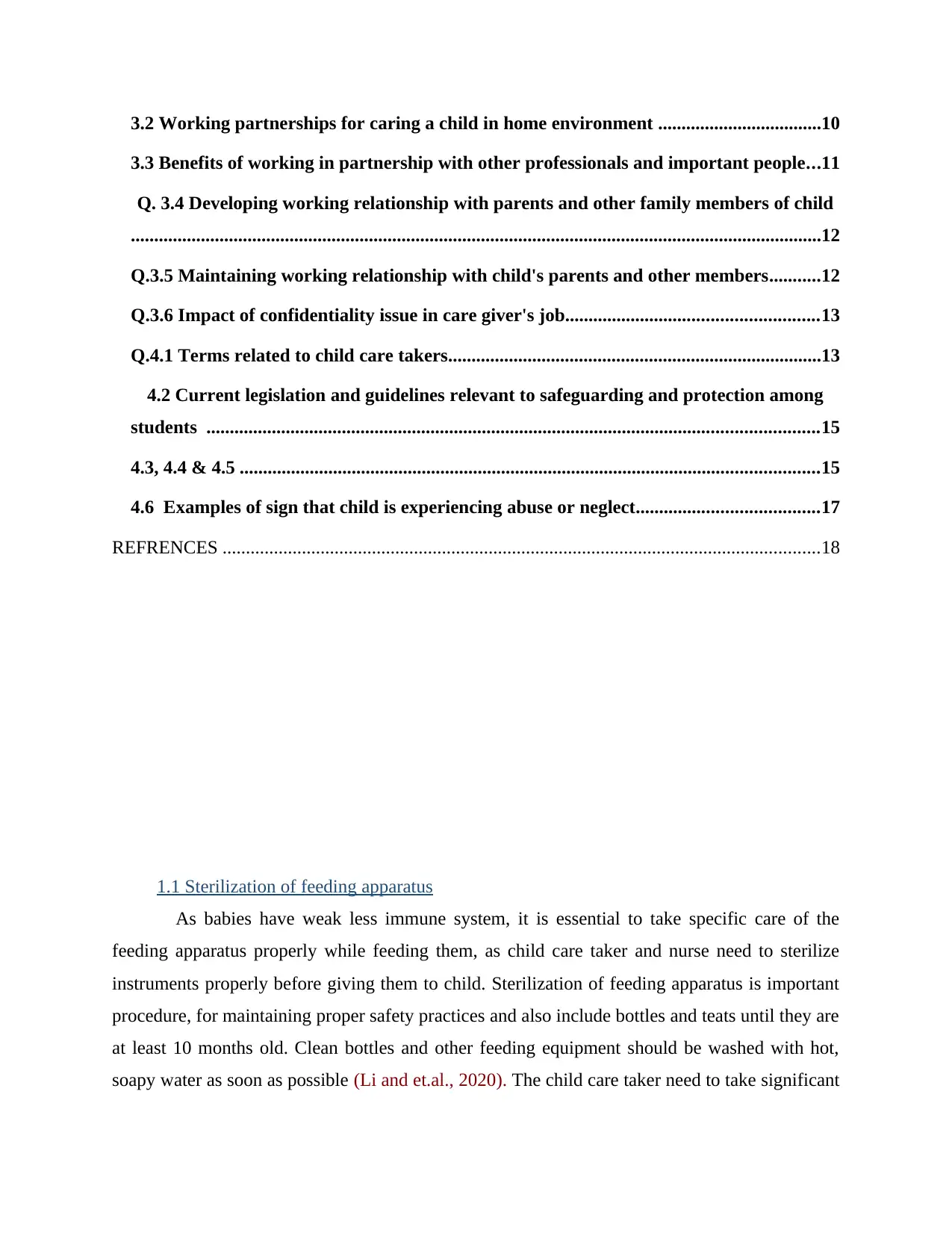
3.2 Working partnerships for caring a child in home environment ...................................10
3.3 Benefits of working in partnership with other professionals and important people...11
Q. 3.4 Developing working relationship with parents and other family members of child
....................................................................................................................................................12
Q.3.5 Maintaining working relationship with child's parents and other members...........12
Q.3.6 Impact of confidentiality issue in care giver's job......................................................13
Q.4.1 Terms related to child care takers................................................................................13
4.2 Current legislation and guidelines relevant to safeguarding and protection among
students ...................................................................................................................................15
4.3, 4.4 & 4.5 ............................................................................................................................15
4.6 Examples of sign that child is experiencing abuse or neglect.......................................17
REFRENCES ................................................................................................................................18
1.1 Sterilization of feeding apparatus
As babies have weak less immune system, it is essential to take specific care of the
feeding apparatus properly while feeding them, as child care taker and nurse need to sterilize
instruments properly before giving them to child. Sterilization of feeding apparatus is important
procedure, for maintaining proper safety practices and also include bottles and teats until they are
at least 10 months old. Clean bottles and other feeding equipment should be washed with hot,
soapy water as soon as possible (Li and et.al., 2020). The child care taker need to take significant
3.3 Benefits of working in partnership with other professionals and important people...11
Q. 3.4 Developing working relationship with parents and other family members of child
....................................................................................................................................................12
Q.3.5 Maintaining working relationship with child's parents and other members...........12
Q.3.6 Impact of confidentiality issue in care giver's job......................................................13
Q.4.1 Terms related to child care takers................................................................................13
4.2 Current legislation and guidelines relevant to safeguarding and protection among
students ...................................................................................................................................15
4.3, 4.4 & 4.5 ............................................................................................................................15
4.6 Examples of sign that child is experiencing abuse or neglect.......................................17
REFRENCES ................................................................................................................................18
1.1 Sterilization of feeding apparatus
As babies have weak less immune system, it is essential to take specific care of the
feeding apparatus properly while feeding them, as child care taker and nurse need to sterilize
instruments properly before giving them to child. Sterilization of feeding apparatus is important
procedure, for maintaining proper safety practices and also include bottles and teats until they are
at least 10 months old. Clean bottles and other feeding equipment should be washed with hot,
soapy water as soon as possible (Li and et.al., 2020). The child care taker need to take significant
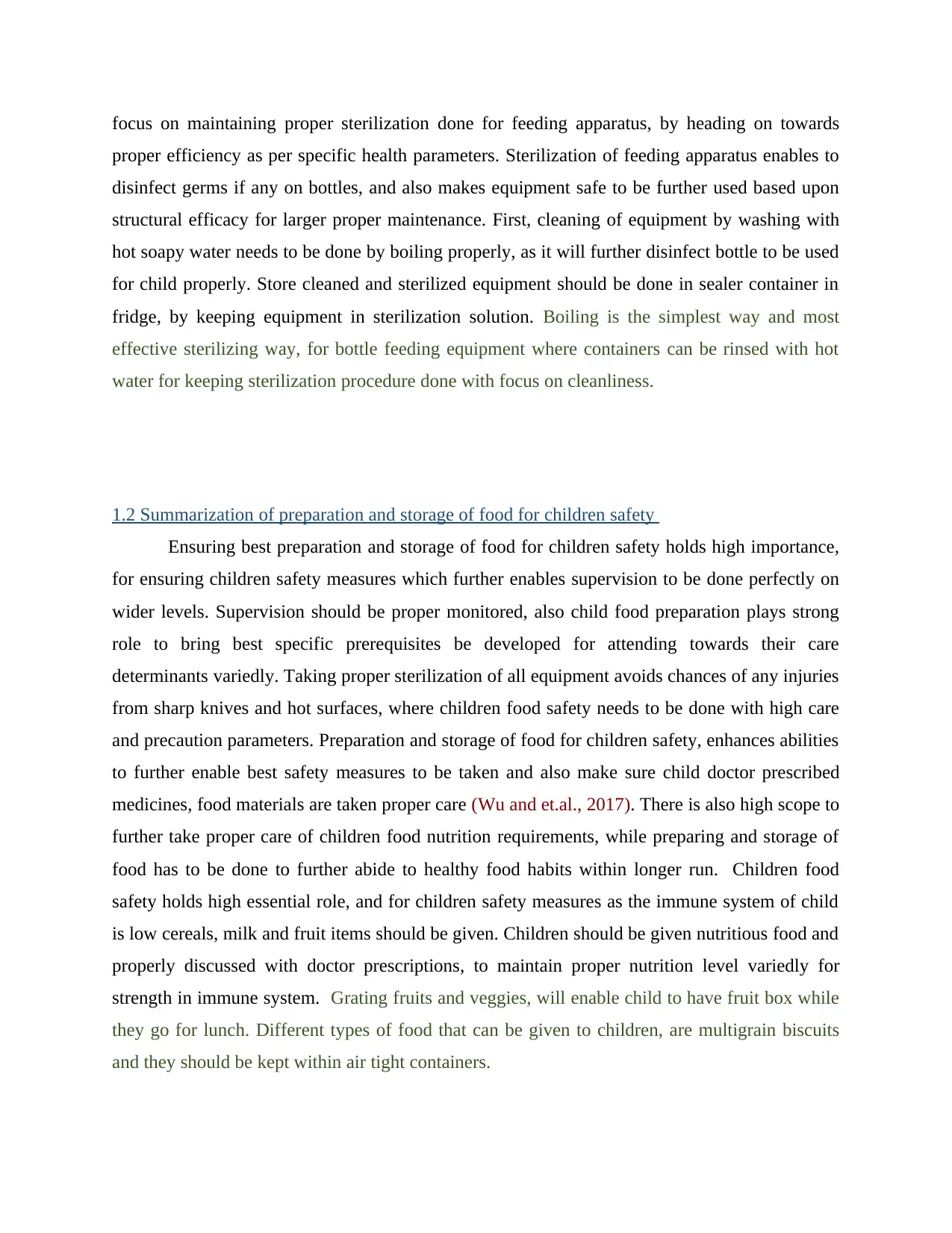
focus on maintaining proper sterilization done for feeding apparatus, by heading on towards
proper efficiency as per specific health parameters. Sterilization of feeding apparatus enables to
disinfect germs if any on bottles, and also makes equipment safe to be further used based upon
structural efficacy for larger proper maintenance. First, cleaning of equipment by washing with
hot soapy water needs to be done by boiling properly, as it will further disinfect bottle to be used
for child properly. Store cleaned and sterilized equipment should be done in sealer container in
fridge, by keeping equipment in sterilization solution. Boiling is the simplest way and most
effective sterilizing way, for bottle feeding equipment where containers can be rinsed with hot
water for keeping sterilization procedure done with focus on cleanliness.
1.2 Summarization of preparation and storage of food for children safety
Ensuring best preparation and storage of food for children safety holds high importance,
for ensuring children safety measures which further enables supervision to be done perfectly on
wider levels. Supervision should be proper monitored, also child food preparation plays strong
role to bring best specific prerequisites be developed for attending towards their care
determinants variedly. Taking proper sterilization of all equipment avoids chances of any injuries
from sharp knives and hot surfaces, where children food safety needs to be done with high care
and precaution parameters. Preparation and storage of food for children safety, enhances abilities
to further enable best safety measures to be taken and also make sure child doctor prescribed
medicines, food materials are taken proper care (Wu and et.al., 2017). There is also high scope to
further take proper care of children food nutrition requirements, while preparing and storage of
food has to be done to further abide to healthy food habits within longer run. Children food
safety holds high essential role, and for children safety measures as the immune system of child
is low cereals, milk and fruit items should be given. Children should be given nutritious food and
properly discussed with doctor prescriptions, to maintain proper nutrition level variedly for
strength in immune system. Grating fruits and veggies, will enable child to have fruit box while
they go for lunch. Different types of food that can be given to children, are multigrain biscuits
and they should be kept within air tight containers.
proper efficiency as per specific health parameters. Sterilization of feeding apparatus enables to
disinfect germs if any on bottles, and also makes equipment safe to be further used based upon
structural efficacy for larger proper maintenance. First, cleaning of equipment by washing with
hot soapy water needs to be done by boiling properly, as it will further disinfect bottle to be used
for child properly. Store cleaned and sterilized equipment should be done in sealer container in
fridge, by keeping equipment in sterilization solution. Boiling is the simplest way and most
effective sterilizing way, for bottle feeding equipment where containers can be rinsed with hot
water for keeping sterilization procedure done with focus on cleanliness.
1.2 Summarization of preparation and storage of food for children safety
Ensuring best preparation and storage of food for children safety holds high importance,
for ensuring children safety measures which further enables supervision to be done perfectly on
wider levels. Supervision should be proper monitored, also child food preparation plays strong
role to bring best specific prerequisites be developed for attending towards their care
determinants variedly. Taking proper sterilization of all equipment avoids chances of any injuries
from sharp knives and hot surfaces, where children food safety needs to be done with high care
and precaution parameters. Preparation and storage of food for children safety, enhances abilities
to further enable best safety measures to be taken and also make sure child doctor prescribed
medicines, food materials are taken proper care (Wu and et.al., 2017). There is also high scope to
further take proper care of children food nutrition requirements, while preparing and storage of
food has to be done to further abide to healthy food habits within longer run. Children food
safety holds high essential role, and for children safety measures as the immune system of child
is low cereals, milk and fruit items should be given. Children should be given nutritious food and
properly discussed with doctor prescriptions, to maintain proper nutrition level variedly for
strength in immune system. Grating fruits and veggies, will enable child to have fruit box while
they go for lunch. Different types of food that can be given to children, are multigrain biscuits
and they should be kept within air tight containers.
Secure Best Marks with AI Grader
Need help grading? Try our AI Grader for instant feedback on your assignments.
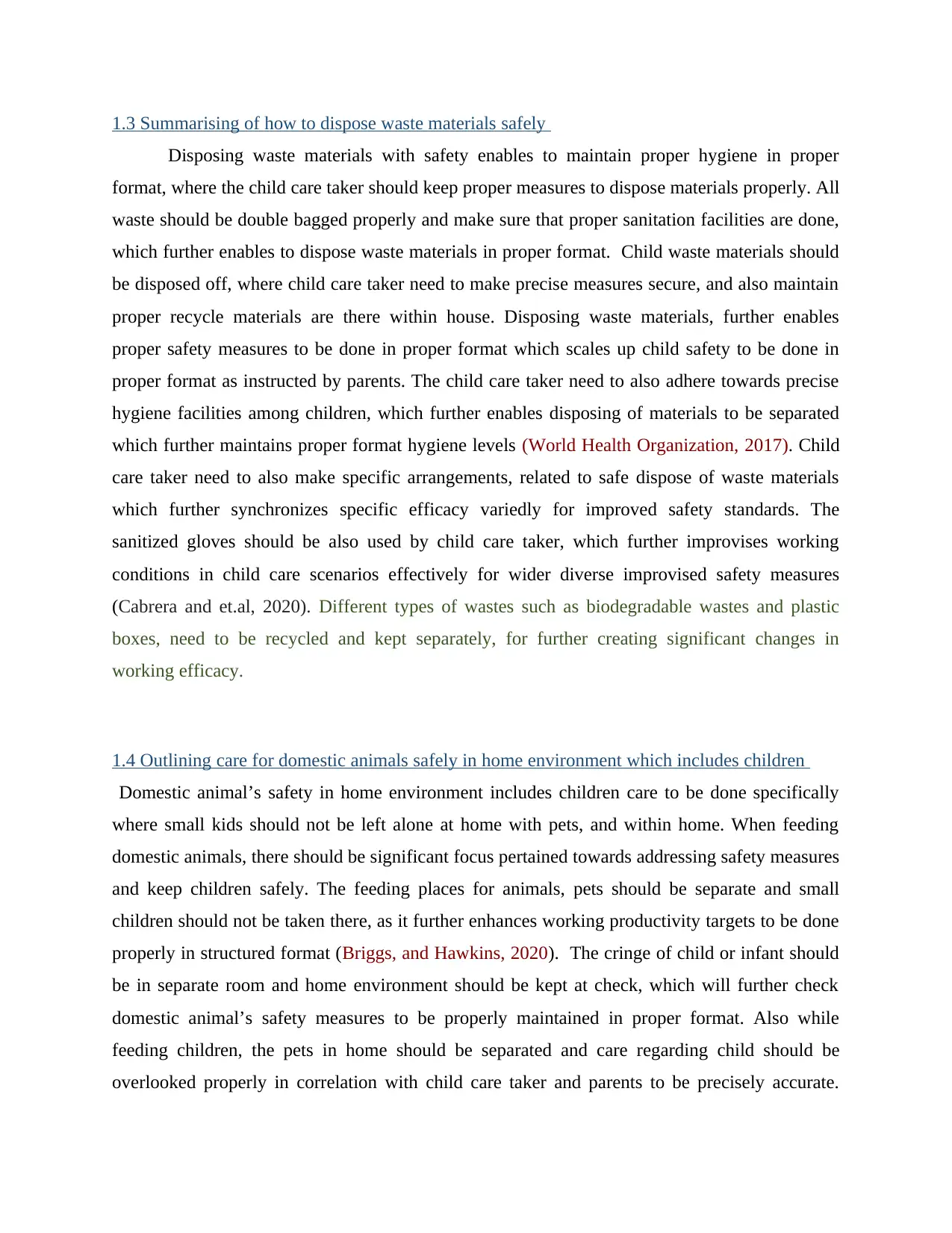
1.3 Summarising of how to dispose waste materials safely
Disposing waste materials with safety enables to maintain proper hygiene in proper
format, where the child care taker should keep proper measures to dispose materials properly. All
waste should be double bagged properly and make sure that proper sanitation facilities are done,
which further enables to dispose waste materials in proper format. Child waste materials should
be disposed off, where child care taker need to make precise measures secure, and also maintain
proper recycle materials are there within house. Disposing waste materials, further enables
proper safety measures to be done in proper format which scales up child safety to be done in
proper format as instructed by parents. The child care taker need to also adhere towards precise
hygiene facilities among children, which further enables disposing of materials to be separated
which further maintains proper format hygiene levels (World Health Organization, 2017). Child
care taker need to also make specific arrangements, related to safe dispose of waste materials
which further synchronizes specific efficacy variedly for improved safety standards. The
sanitized gloves should be also used by child care taker, which further improvises working
conditions in child care scenarios effectively for wider diverse improvised safety measures
(Cabrera and et.al, 2020). Different types of wastes such as biodegradable wastes and plastic
boxes, need to be recycled and kept separately, for further creating significant changes in
working efficacy.
1.4 Outlining care for domestic animals safely in home environment which includes children
Domestic animal’s safety in home environment includes children care to be done specifically
where small kids should not be left alone at home with pets, and within home. When feeding
domestic animals, there should be significant focus pertained towards addressing safety measures
and keep children safely. The feeding places for animals, pets should be separate and small
children should not be taken there, as it further enhances working productivity targets to be done
properly in structured format (Briggs, and Hawkins, 2020). The cringe of child or infant should
be in separate room and home environment should be kept at check, which will further check
domestic animal’s safety measures to be properly maintained in proper format. Also while
feeding children, the pets in home should be separated and care regarding child should be
overlooked properly in correlation with child care taker and parents to be precisely accurate.
Disposing waste materials with safety enables to maintain proper hygiene in proper
format, where the child care taker should keep proper measures to dispose materials properly. All
waste should be double bagged properly and make sure that proper sanitation facilities are done,
which further enables to dispose waste materials in proper format. Child waste materials should
be disposed off, where child care taker need to make precise measures secure, and also maintain
proper recycle materials are there within house. Disposing waste materials, further enables
proper safety measures to be done in proper format which scales up child safety to be done in
proper format as instructed by parents. The child care taker need to also adhere towards precise
hygiene facilities among children, which further enables disposing of materials to be separated
which further maintains proper format hygiene levels (World Health Organization, 2017). Child
care taker need to also make specific arrangements, related to safe dispose of waste materials
which further synchronizes specific efficacy variedly for improved safety standards. The
sanitized gloves should be also used by child care taker, which further improvises working
conditions in child care scenarios effectively for wider diverse improvised safety measures
(Cabrera and et.al, 2020). Different types of wastes such as biodegradable wastes and plastic
boxes, need to be recycled and kept separately, for further creating significant changes in
working efficacy.
1.4 Outlining care for domestic animals safely in home environment which includes children
Domestic animal’s safety in home environment includes children care to be done specifically
where small kids should not be left alone at home with pets, and within home. When feeding
domestic animals, there should be significant focus pertained towards addressing safety measures
and keep children safely. The feeding places for animals, pets should be separate and small
children should not be taken there, as it further enhances working productivity targets to be done
properly in structured format (Briggs, and Hawkins, 2020). The cringe of child or infant should
be in separate room and home environment should be kept at check, which will further check
domestic animal’s safety measures to be properly maintained in proper format. Also while
feeding children, the pets in home should be separated and care regarding child should be
overlooked properly in correlation with child care taker and parents to be precisely accurate.
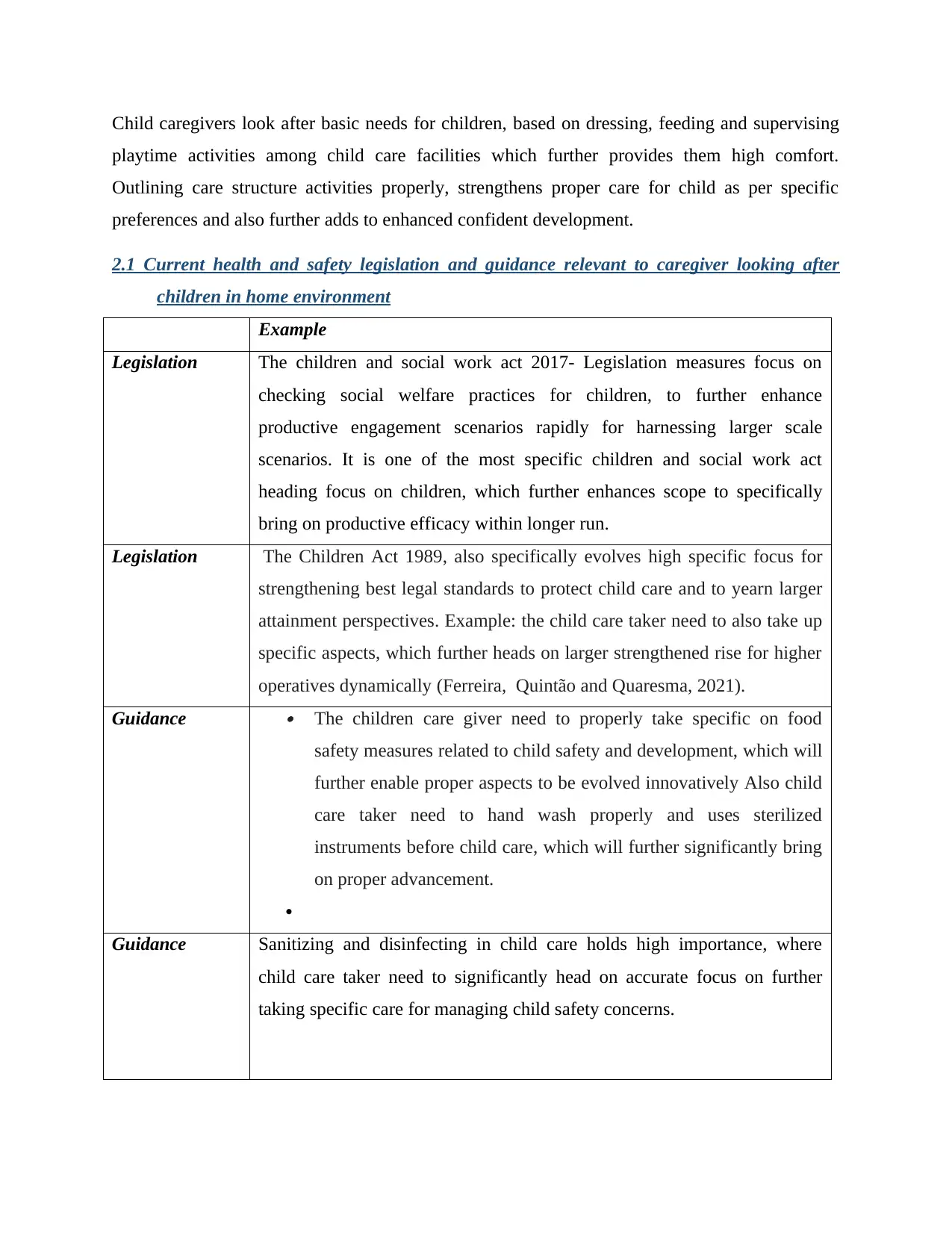
Child caregivers look after basic needs for children, based on dressing, feeding and supervising
playtime activities among child care facilities which further provides them high comfort.
Outlining care structure activities properly, strengthens proper care for child as per specific
preferences and also further adds to enhanced confident development.
2.1 Current health and safety legislation and guidance relevant to caregiver looking after
children in home environment
Example
Legislation The children and social work act 2017- Legislation measures focus on
checking social welfare practices for children, to further enhance
productive engagement scenarios rapidly for harnessing larger scale
scenarios. It is one of the most specific children and social work act
heading focus on children, which further enhances scope to specifically
bring on productive efficacy within longer run.
Legislation The Children Act 1989, also specifically evolves high specific focus for
strengthening best legal standards to protect child care and to yearn larger
attainment perspectives. Example: the child care taker need to also take up
specific aspects, which further heads on larger strengthened rise for higher
operatives dynamically (Ferreira, Quintão and Quaresma, 2021).
Guidance
The children care giver need to properly take specific on food
safety measures related to child safety and development, which will
further enable proper aspects to be evolved innovatively Also child
care taker need to hand wash properly and uses sterilized
instruments before child care, which will further significantly bring
on proper advancement.
Guidance Sanitizing and disinfecting in child care holds high importance, where
child care taker need to significantly head on accurate focus on further
taking specific care for managing child safety concerns.
playtime activities among child care facilities which further provides them high comfort.
Outlining care structure activities properly, strengthens proper care for child as per specific
preferences and also further adds to enhanced confident development.
2.1 Current health and safety legislation and guidance relevant to caregiver looking after
children in home environment
Example
Legislation The children and social work act 2017- Legislation measures focus on
checking social welfare practices for children, to further enhance
productive engagement scenarios rapidly for harnessing larger scale
scenarios. It is one of the most specific children and social work act
heading focus on children, which further enhances scope to specifically
bring on productive efficacy within longer run.
Legislation The Children Act 1989, also specifically evolves high specific focus for
strengthening best legal standards to protect child care and to yearn larger
attainment perspectives. Example: the child care taker need to also take up
specific aspects, which further heads on larger strengthened rise for higher
operatives dynamically (Ferreira, Quintão and Quaresma, 2021).
Guidance
The children care giver need to properly take specific on food
safety measures related to child safety and development, which will
further enable proper aspects to be evolved innovatively Also child
care taker need to hand wash properly and uses sterilized
instruments before child care, which will further significantly bring
on proper advancement.
Guidance Sanitizing and disinfecting in child care holds high importance, where
child care taker need to significantly head on accurate focus on further
taking specific care for managing child safety concerns.
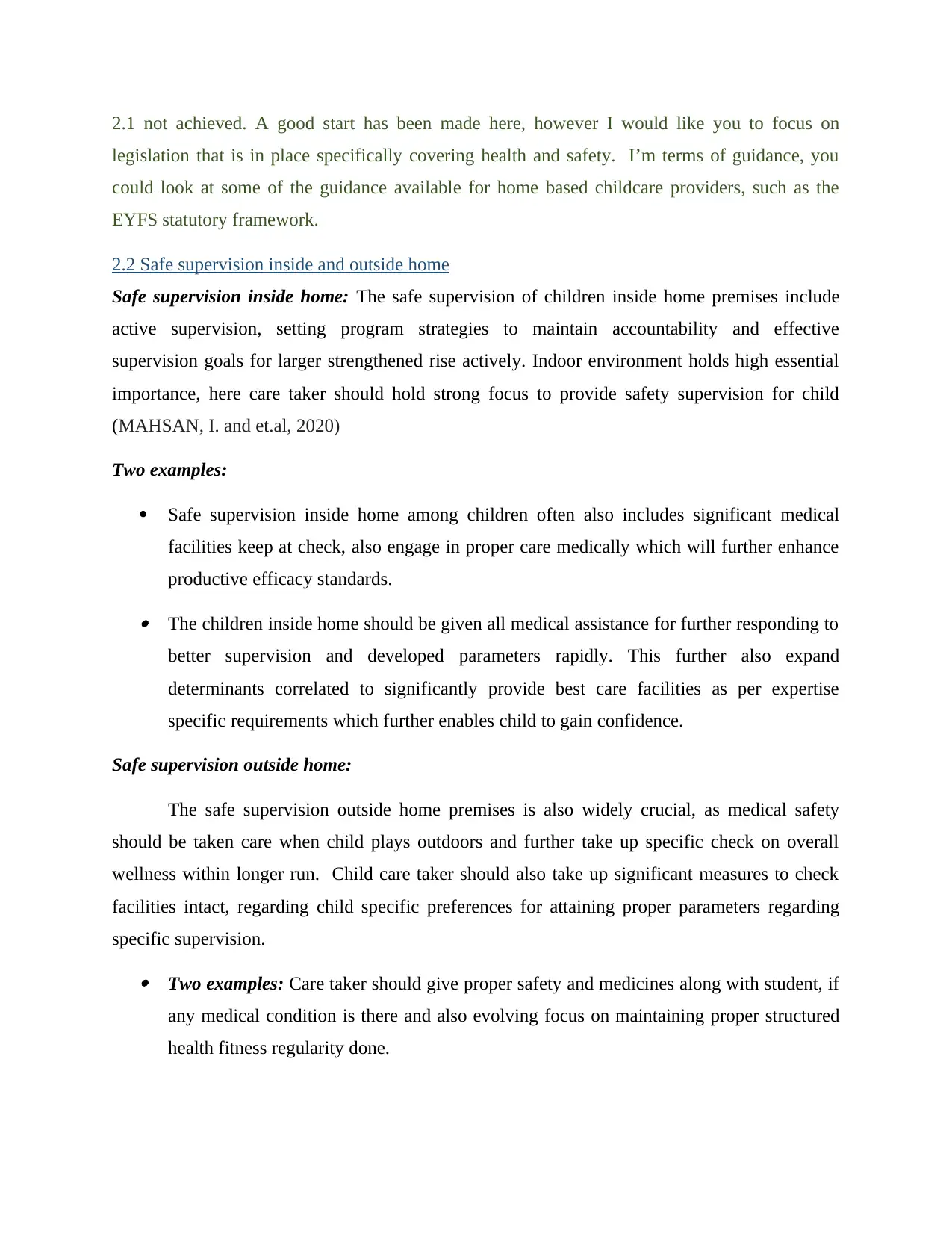
2.1 not achieved. A good start has been made here, however I would like you to focus on
legislation that is in place specifically covering health and safety. I’m terms of guidance, you
could look at some of the guidance available for home based childcare providers, such as the
EYFS statutory framework.
2.2 Safe supervision inside and outside home
Safe supervision inside home: The safe supervision of children inside home premises include
active supervision, setting program strategies to maintain accountability and effective
supervision goals for larger strengthened rise actively. Indoor environment holds high essential
importance, here care taker should hold strong focus to provide safety supervision for child
(MAHSAN, I. and et.al, 2020)
Two examples:
Safe supervision inside home among children often also includes significant medical
facilities keep at check, also engage in proper care medically which will further enhance
productive efficacy standards. The children inside home should be given all medical assistance for further responding to
better supervision and developed parameters rapidly. This further also expand
determinants correlated to significantly provide best care facilities as per expertise
specific requirements which further enables child to gain confidence.
Safe supervision outside home:
The safe supervision outside home premises is also widely crucial, as medical safety
should be taken care when child plays outdoors and further take up specific check on overall
wellness within longer run. Child care taker should also take up significant measures to check
facilities intact, regarding child specific preferences for attaining proper parameters regarding
specific supervision. Two examples: Care taker should give proper safety and medicines along with student, if
any medical condition is there and also evolving focus on maintaining proper structured
health fitness regularity done.
legislation that is in place specifically covering health and safety. I’m terms of guidance, you
could look at some of the guidance available for home based childcare providers, such as the
EYFS statutory framework.
2.2 Safe supervision inside and outside home
Safe supervision inside home: The safe supervision of children inside home premises include
active supervision, setting program strategies to maintain accountability and effective
supervision goals for larger strengthened rise actively. Indoor environment holds high essential
importance, here care taker should hold strong focus to provide safety supervision for child
(MAHSAN, I. and et.al, 2020)
Two examples:
Safe supervision inside home among children often also includes significant medical
facilities keep at check, also engage in proper care medically which will further enhance
productive efficacy standards. The children inside home should be given all medical assistance for further responding to
better supervision and developed parameters rapidly. This further also expand
determinants correlated to significantly provide best care facilities as per expertise
specific requirements which further enables child to gain confidence.
Safe supervision outside home:
The safe supervision outside home premises is also widely crucial, as medical safety
should be taken care when child plays outdoors and further take up specific check on overall
wellness within longer run. Child care taker should also take up significant measures to check
facilities intact, regarding child specific preferences for attaining proper parameters regarding
specific supervision. Two examples: Care taker should give proper safety and medicines along with student, if
any medical condition is there and also evolving focus on maintaining proper structured
health fitness regularity done.
Paraphrase This Document
Need a fresh take? Get an instant paraphrase of this document with our AI Paraphraser
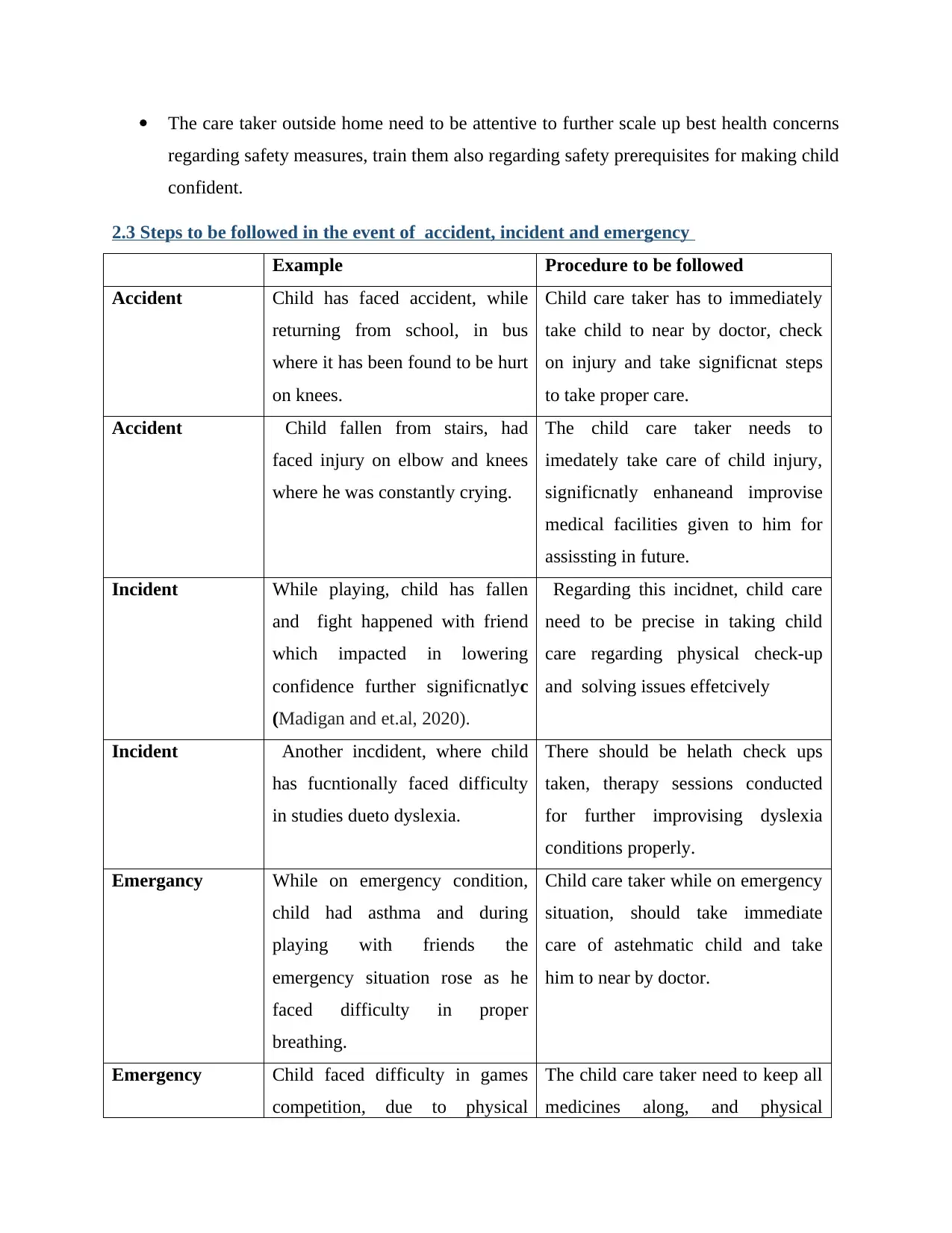
The care taker outside home need to be attentive to further scale up best health concerns
regarding safety measures, train them also regarding safety prerequisites for making child
confident.
2.3 Steps to be followed in the event of accident, incident and emergency
Example Procedure to be followed
Accident Child has faced accident, while
returning from school, in bus
where it has been found to be hurt
on knees.
Child care taker has to immediately
take child to near by doctor, check
on injury and take significnat steps
to take proper care.
Accident Child fallen from stairs, had
faced injury on elbow and knees
where he was constantly crying.
The child care taker needs to
imedately take care of child injury,
significnatly enhaneand improvise
medical facilities given to him for
assissting in future.
Incident While playing, child has fallen
and fight happened with friend
which impacted in lowering
confidence further significnatlyc
(Madigan and et.al, 2020).
Regarding this incidnet, child care
need to be precise in taking child
care regarding physical check-up
and solving issues effetcively
Incident Another incdident, where child
has fucntionally faced difficulty
in studies dueto dyslexia.
There should be helath check ups
taken, therapy sessions conducted
for further improvising dyslexia
conditions properly.
Emergancy While on emergency condition,
child had asthma and during
playing with friends the
emergency situation rose as he
faced difficulty in proper
breathing.
Child care taker while on emergency
situation, should take immediate
care of astehmatic child and take
him to near by doctor.
Emergency Child faced difficulty in games
competition, due to physical
The child care taker need to keep all
medicines along, and physical
regarding safety measures, train them also regarding safety prerequisites for making child
confident.
2.3 Steps to be followed in the event of accident, incident and emergency
Example Procedure to be followed
Accident Child has faced accident, while
returning from school, in bus
where it has been found to be hurt
on knees.
Child care taker has to immediately
take child to near by doctor, check
on injury and take significnat steps
to take proper care.
Accident Child fallen from stairs, had
faced injury on elbow and knees
where he was constantly crying.
The child care taker needs to
imedately take care of child injury,
significnatly enhaneand improvise
medical facilities given to him for
assissting in future.
Incident While playing, child has fallen
and fight happened with friend
which impacted in lowering
confidence further significnatlyc
(Madigan and et.al, 2020).
Regarding this incidnet, child care
need to be precise in taking child
care regarding physical check-up
and solving issues effetcively
Incident Another incdident, where child
has fucntionally faced difficulty
in studies dueto dyslexia.
There should be helath check ups
taken, therapy sessions conducted
for further improvising dyslexia
conditions properly.
Emergancy While on emergency condition,
child had asthma and during
playing with friends the
emergency situation rose as he
faced difficulty in proper
breathing.
Child care taker while on emergency
situation, should take immediate
care of astehmatic child and take
him to near by doctor.
Emergency Child faced difficulty in games
competition, due to physical
The child care taker need to keep all
medicines along, and physical
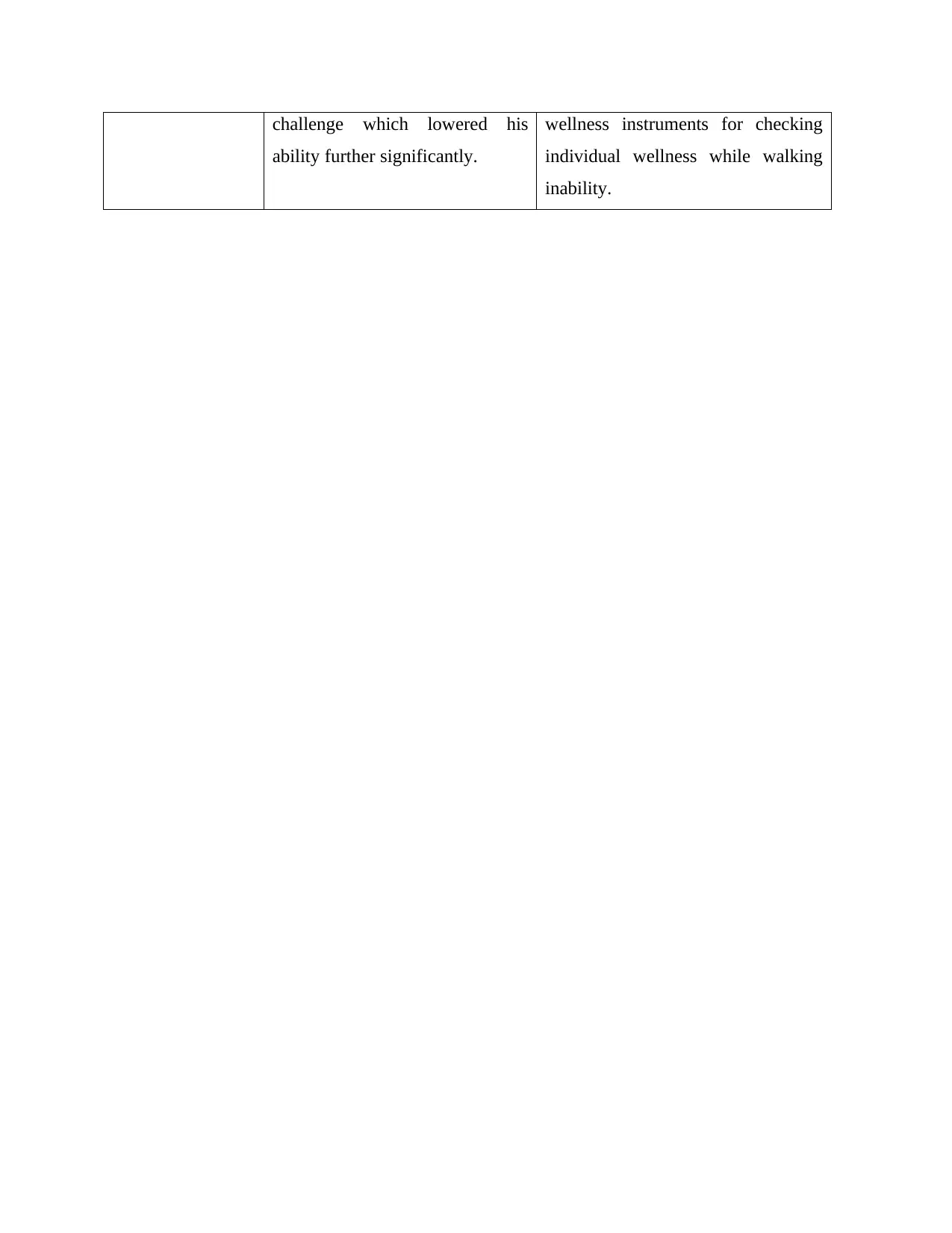
challenge which lowered his
ability further significantly.
wellness instruments for checking
individual wellness while walking
inability.
ability further significantly.
wellness instruments for checking
individual wellness while walking
inability.

Incident is an instance of something happening, where an unexpected event or occurrence is
there in form of some serious injury or illness which may result in damage. Emergency on other
hand demands immediate and medical attention which hampers physical being, where minor
accidents can be solved by first aid attention and also taking up medical care. Bumped knee
would need definitely immediate medical condition.
2.4 Outlining safely store and administration of medication to child in care
Store and administration of medication to child in care plays strong role for signifying
dose of new medicine to child, where parents should give at least one dose for ensuring child
does not have any adverse reaction to medication. Safely storage and administration of
medication further enhances abilities in child for taking, and also to keep further productive child
care done in proper format. Medications should be given proper to children in care, for attaining
significant rise diversely and to also be specific in their timings where safely storage further
opens up scope for specific nursing practices. Allergies in any faced by child should be further
discussed properly by doctor of child, which further enables medication to be done in proper
format done which further technically advances child care. Medication to child care should also
be done in proper specific format, where safety measures such as storing in sanitized medicated
boxes will further enhance abilities to be taken (Briggs and Hawkins, 2020). This will also
further strengthen up focus on proper medication practices to be taken for child care by care
taker, doctor and parents associated within the child. Outlined proper safety store and
administration of proper medication adds to child care practices to be done in proper format,
further adding to functional integrity aspects and also to keep child care practices done properly.
If a parent asked you to give their child medicine, there should be information attained about
medical history of child, where parents need to give all details regarding allergies if any faced
and also take proper care further. Medicines are stored in good container, where storage aspects
need to be taken care of properly.
there in form of some serious injury or illness which may result in damage. Emergency on other
hand demands immediate and medical attention which hampers physical being, where minor
accidents can be solved by first aid attention and also taking up medical care. Bumped knee
would need definitely immediate medical condition.
2.4 Outlining safely store and administration of medication to child in care
Store and administration of medication to child in care plays strong role for signifying
dose of new medicine to child, where parents should give at least one dose for ensuring child
does not have any adverse reaction to medication. Safely storage and administration of
medication further enhances abilities in child for taking, and also to keep further productive child
care done in proper format. Medications should be given proper to children in care, for attaining
significant rise diversely and to also be specific in their timings where safely storage further
opens up scope for specific nursing practices. Allergies in any faced by child should be further
discussed properly by doctor of child, which further enables medication to be done in proper
format done which further technically advances child care. Medication to child care should also
be done in proper specific format, where safety measures such as storing in sanitized medicated
boxes will further enhance abilities to be taken (Briggs and Hawkins, 2020). This will also
further strengthen up focus on proper medication practices to be taken for child care by care
taker, doctor and parents associated within the child. Outlined proper safety store and
administration of proper medication adds to child care practices to be done in proper format,
further adding to functional integrity aspects and also to keep child care practices done properly.
If a parent asked you to give their child medicine, there should be information attained about
medical history of child, where parents need to give all details regarding allergies if any faced
and also take proper care further. Medicines are stored in good container, where storage aspects
need to be taken care of properly.
Secure Best Marks with AI Grader
Need help grading? Try our AI Grader for instant feedback on your assignments.

3.1 Role of child care taker and others when planning next steps for child preferences and
requirements
Child care taker and parents have specific role when planning next steps for child
preferences and specific working requirements, where there should be proper formal
communication done in planned format for ensuring support children to make smooth and
successful care. Child care taker should hold specific precise focus on child preferences and
requirements, where information such as feeding time of child, sleeping and changing routines
should be done in proper planned format. The child care taker needs need to also keep in mind
nutrition food to be given to child, when planning meals which should be also taken proper
guidance from child doctor and family members. There should be proper discussion done
regarding child preferences, living habits which enhances abilities and communication platforms
to be strengthened properly. The child care taker should also be present while discussion and
meetings with parents, for proper communication further which adds to efficiency standards
variedly within longer run variedly. Also child care taker is responsible for maintaining precise
child preferences in check, which primitively enables proper child care to be done in proper
format which further improves overall active steps to be done. Child care taker need to also be
specific in safety measures, and regarding preferences for evolved rapid rise on requirements
which further opens up high scope variedly towards strengthened scope variedly (Beelmann and
Lösel., 2021). Role of child care taker is to analyze best specifics within role for keeping take
care of child, and also attending specific details about child preferences from parents and plan up
specific procedures for taking care significantly.
3.2 Working partnerships for caring a child in home environment
The career needs to have working partnerships formed with cooperation and dedication,
for caring a child in home environment which can be understood and segregated with the basis of
fundamental competencies and significant role.
Type of partnership Example
Child care taker need to be attentive towards building effective
work partnership with parents, for strengthening child
requirements
Child care taker and parents have specific role when planning next steps for child
preferences and specific working requirements, where there should be proper formal
communication done in planned format for ensuring support children to make smooth and
successful care. Child care taker should hold specific precise focus on child preferences and
requirements, where information such as feeding time of child, sleeping and changing routines
should be done in proper planned format. The child care taker needs need to also keep in mind
nutrition food to be given to child, when planning meals which should be also taken proper
guidance from child doctor and family members. There should be proper discussion done
regarding child preferences, living habits which enhances abilities and communication platforms
to be strengthened properly. The child care taker should also be present while discussion and
meetings with parents, for proper communication further which adds to efficiency standards
variedly within longer run variedly. Also child care taker is responsible for maintaining precise
child preferences in check, which primitively enables proper child care to be done in proper
format which further improves overall active steps to be done. Child care taker need to also be
specific in safety measures, and regarding preferences for evolved rapid rise on requirements
which further opens up high scope variedly towards strengthened scope variedly (Beelmann and
Lösel., 2021). Role of child care taker is to analyze best specifics within role for keeping take
care of child, and also attending specific details about child preferences from parents and plan up
specific procedures for taking care significantly.
3.2 Working partnerships for caring a child in home environment
The career needs to have working partnerships formed with cooperation and dedication,
for caring a child in home environment which can be understood and segregated with the basis of
fundamental competencies and significant role.
Type of partnership Example
Child care taker need to be attentive towards building effective
work partnership with parents, for strengthening child
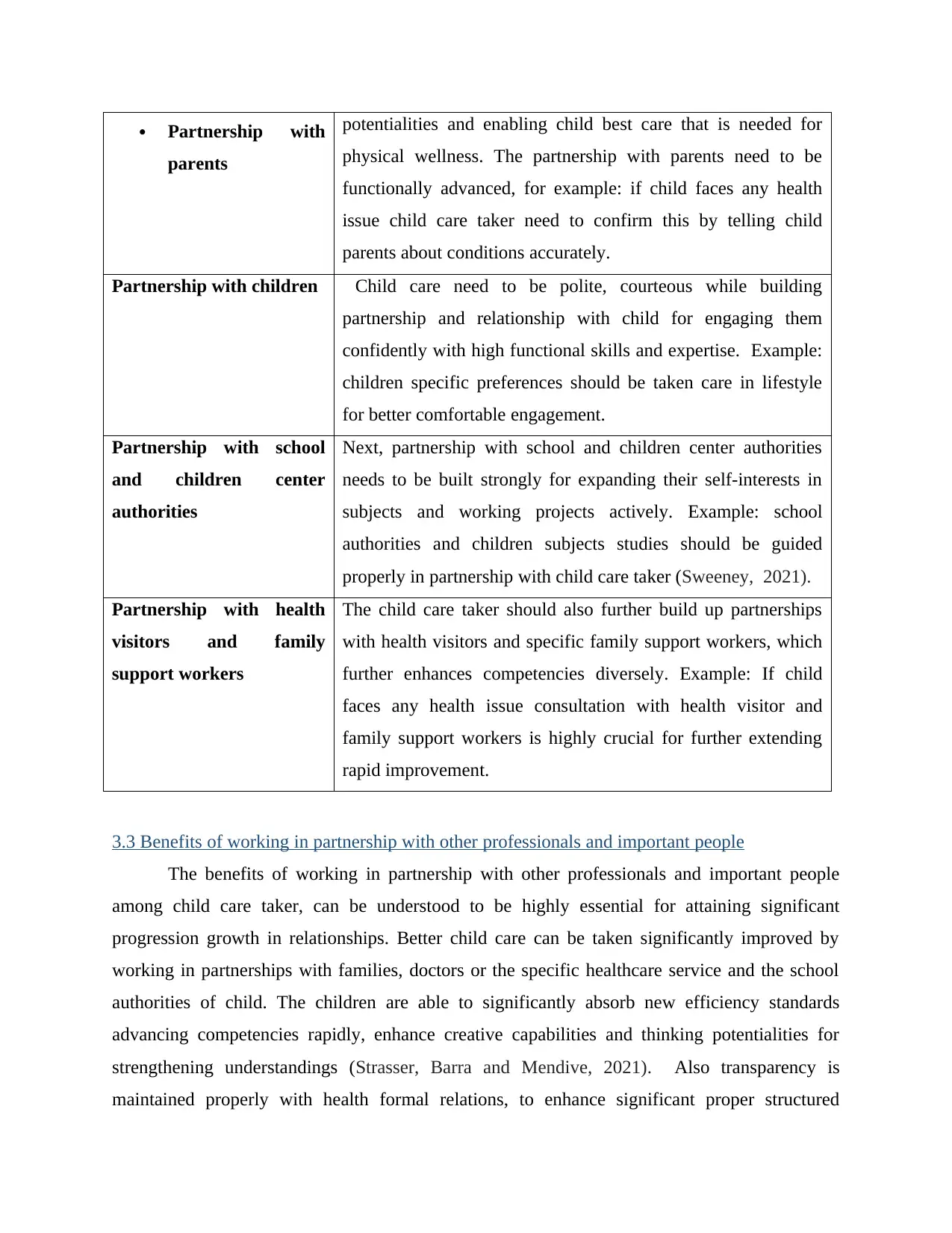
Partnership with
parents
potentialities and enabling child best care that is needed for
physical wellness. The partnership with parents need to be
functionally advanced, for example: if child faces any health
issue child care taker need to confirm this by telling child
parents about conditions accurately.
Partnership with children Child care need to be polite, courteous while building
partnership and relationship with child for engaging them
confidently with high functional skills and expertise. Example:
children specific preferences should be taken care in lifestyle
for better comfortable engagement.
Partnership with school
and children center
authorities
Next, partnership with school and children center authorities
needs to be built strongly for expanding their self-interests in
subjects and working projects actively. Example: school
authorities and children subjects studies should be guided
properly in partnership with child care taker (Sweeney, 2021).
Partnership with health
visitors and family
support workers
The child care taker should also further build up partnerships
with health visitors and specific family support workers, which
further enhances competencies diversely. Example: If child
faces any health issue consultation with health visitor and
family support workers is highly crucial for further extending
rapid improvement.
3.3 Benefits of working in partnership with other professionals and important people
The benefits of working in partnership with other professionals and important people
among child care taker, can be understood to be highly essential for attaining significant
progression growth in relationships. Better child care can be taken significantly improved by
working in partnerships with families, doctors or the specific healthcare service and the school
authorities of child. The children are able to significantly absorb new efficiency standards
advancing competencies rapidly, enhance creative capabilities and thinking potentialities for
strengthening understandings (Strasser, Barra and Mendive, 2021). Also transparency is
maintained properly with health formal relations, to enhance significant proper structured
parents
potentialities and enabling child best care that is needed for
physical wellness. The partnership with parents need to be
functionally advanced, for example: if child faces any health
issue child care taker need to confirm this by telling child
parents about conditions accurately.
Partnership with children Child care need to be polite, courteous while building
partnership and relationship with child for engaging them
confidently with high functional skills and expertise. Example:
children specific preferences should be taken care in lifestyle
for better comfortable engagement.
Partnership with school
and children center
authorities
Next, partnership with school and children center authorities
needs to be built strongly for expanding their self-interests in
subjects and working projects actively. Example: school
authorities and children subjects studies should be guided
properly in partnership with child care taker (Sweeney, 2021).
Partnership with health
visitors and family
support workers
The child care taker should also further build up partnerships
with health visitors and specific family support workers, which
further enhances competencies diversely. Example: If child
faces any health issue consultation with health visitor and
family support workers is highly crucial for further extending
rapid improvement.
3.3 Benefits of working in partnership with other professionals and important people
The benefits of working in partnership with other professionals and important people
among child care taker, can be understood to be highly essential for attaining significant
progression growth in relationships. Better child care can be taken significantly improved by
working in partnerships with families, doctors or the specific healthcare service and the school
authorities of child. The children are able to significantly absorb new efficiency standards
advancing competencies rapidly, enhance creative capabilities and thinking potentialities for
strengthening understandings (Strasser, Barra and Mendive, 2021). Also transparency is
maintained properly with health formal relations, to enhance significant proper structured

efficacy competencies diversely towards new paradigms diversely. There is also high scale
specific progression attached to proper leveraged rise in child care services, when partnership
with professionals and important people is properly maintained within daily routine. It can be
also understood that regular meeting sessions, working in partnership enhances scope to enhance
overall integral people involvement for child care scenarios innovatively in proper format.
Taking up significant new steps to enhance child medical condition and harness creative efficacy
standards are worked on, further engaging towards best potentialities actively to strengthen up
child intensive care.
Q. 3.4 Developing working relationship with parents and other family members of child
When starting the job as the caregiver, they should develop a bond with the child as well
as the family members to make them feel comfortable about the babysitter around their child and
the other people of the family. The caregiver must ensure that they make positive impression on
the family and the parents. The parents might have the second thoughts about the decision. So
the caretaker must clear their doubts. When the associate family members ask any questions the
caretaker must reply them very patiently (In-Home Caregiver Tips for a Successful First Day on
the Job, 2021). They must offer love and respect to the family. They must ask the parents about
the child's health, behaviour, and routine and be acceptable about that. If they find any problem
about anything related to their child they must guide the parents politely.
The caretaker must be positively confident and give them the impression of
professionalism, this will help to garner the trust. The child carer must try to build a personal
relationship with the members related to the child. However building a relationship takes time,
but they should try to match the common interests, talking about themselves and their family.
The caretaker must talk about the preferences of the people in the family about the child. They
should be professional in terms of knowledge about their job and being on time (Joseph and
et.al., 2020)..
Q.3.5 Maintaining working relationship with child's parents and other members
For maintaining the relationship with the guardian and the other significant, the carer
must ensure that they are consistent from the day they have joined their tasks in the home. They
must ensure that faith they have in the service provider should be maintained. The care taker
should be very flexible with the family. They must be transparent about their child's health and
specific progression attached to proper leveraged rise in child care services, when partnership
with professionals and important people is properly maintained within daily routine. It can be
also understood that regular meeting sessions, working in partnership enhances scope to enhance
overall integral people involvement for child care scenarios innovatively in proper format.
Taking up significant new steps to enhance child medical condition and harness creative efficacy
standards are worked on, further engaging towards best potentialities actively to strengthen up
child intensive care.
Q. 3.4 Developing working relationship with parents and other family members of child
When starting the job as the caregiver, they should develop a bond with the child as well
as the family members to make them feel comfortable about the babysitter around their child and
the other people of the family. The caregiver must ensure that they make positive impression on
the family and the parents. The parents might have the second thoughts about the decision. So
the caretaker must clear their doubts. When the associate family members ask any questions the
caretaker must reply them very patiently (In-Home Caregiver Tips for a Successful First Day on
the Job, 2021). They must offer love and respect to the family. They must ask the parents about
the child's health, behaviour, and routine and be acceptable about that. If they find any problem
about anything related to their child they must guide the parents politely.
The caretaker must be positively confident and give them the impression of
professionalism, this will help to garner the trust. The child carer must try to build a personal
relationship with the members related to the child. However building a relationship takes time,
but they should try to match the common interests, talking about themselves and their family.
The caretaker must talk about the preferences of the people in the family about the child. They
should be professional in terms of knowledge about their job and being on time (Joseph and
et.al., 2020)..
Q.3.5 Maintaining working relationship with child's parents and other members
For maintaining the relationship with the guardian and the other significant, the carer
must ensure that they are consistent from the day they have joined their tasks in the home. They
must ensure that faith they have in the service provider should be maintained. The care taker
should be very flexible with the family. They must be transparent about their child's health and
Paraphrase This Document
Need a fresh take? Get an instant paraphrase of this document with our AI Paraphraser
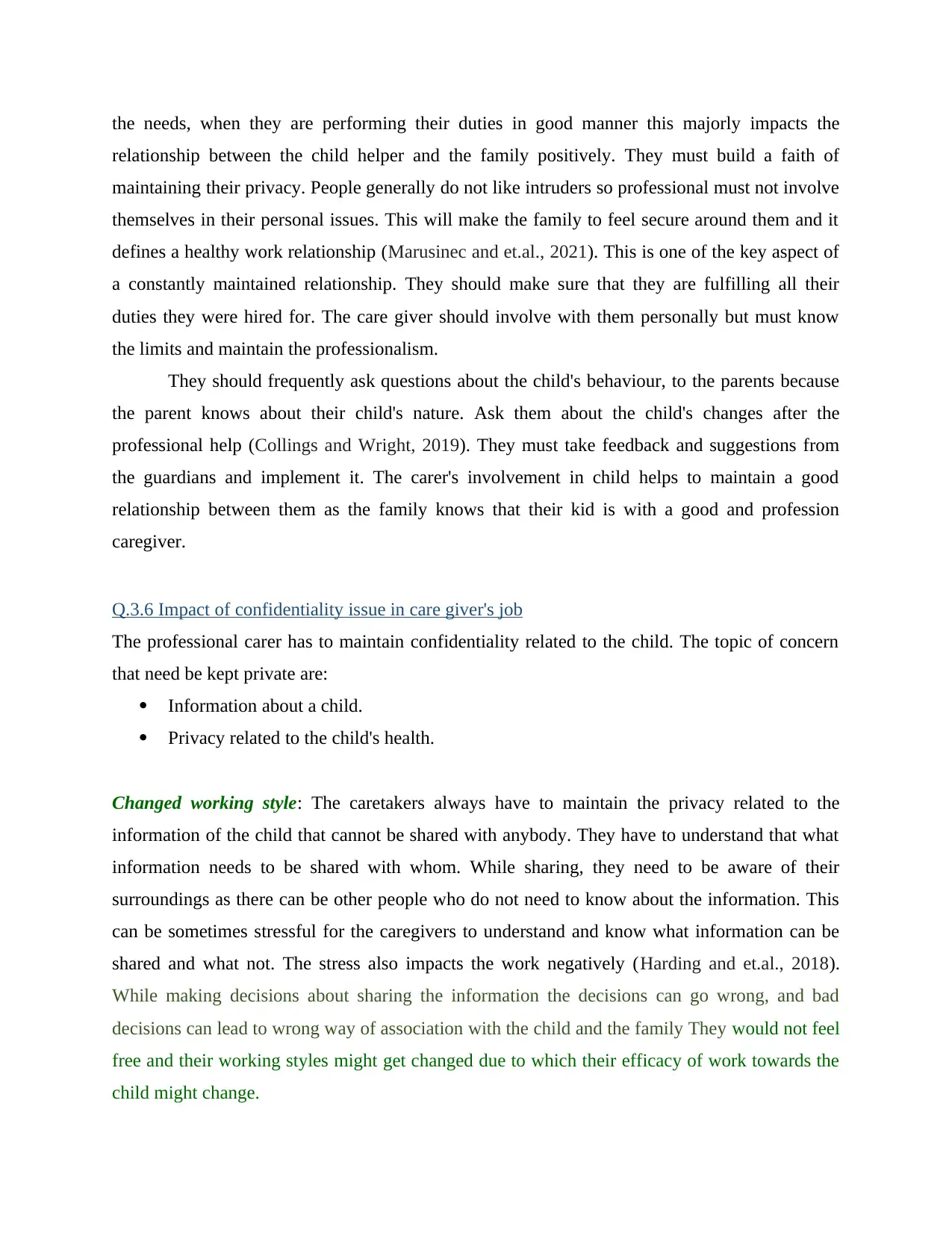
the needs, when they are performing their duties in good manner this majorly impacts the
relationship between the child helper and the family positively. They must build a faith of
maintaining their privacy. People generally do not like intruders so professional must not involve
themselves in their personal issues. This will make the family to feel secure around them and it
defines a healthy work relationship (Marusinec and et.al., 2021). This is one of the key aspect of
a constantly maintained relationship. They should make sure that they are fulfilling all their
duties they were hired for. The care giver should involve with them personally but must know
the limits and maintain the professionalism.
They should frequently ask questions about the child's behaviour, to the parents because
the parent knows about their child's nature. Ask them about the child's changes after the
professional help (Collings and Wright, 2019). They must take feedback and suggestions from
the guardians and implement it. The carer's involvement in child helps to maintain a good
relationship between them as the family knows that their kid is with a good and profession
caregiver.
Q.3.6 Impact of confidentiality issue in care giver's job
The professional carer has to maintain confidentiality related to the child. The topic of concern
that need be kept private are:
Information about a child.
Privacy related to the child's health.
Changed working style: The caretakers always have to maintain the privacy related to the
information of the child that cannot be shared with anybody. They have to understand that what
information needs to be shared with whom. While sharing, they need to be aware of their
surroundings as there can be other people who do not need to know about the information. This
can be sometimes stressful for the caregivers to understand and know what information can be
shared and what not. The stress also impacts the work negatively (Harding and et.al., 2018).
While making decisions about sharing the information the decisions can go wrong, and bad
decisions can lead to wrong way of association with the child and the family They would not feel
free and their working styles might get changed due to which their efficacy of work towards the
child might change.
relationship between the child helper and the family positively. They must build a faith of
maintaining their privacy. People generally do not like intruders so professional must not involve
themselves in their personal issues. This will make the family to feel secure around them and it
defines a healthy work relationship (Marusinec and et.al., 2021). This is one of the key aspect of
a constantly maintained relationship. They should make sure that they are fulfilling all their
duties they were hired for. The care giver should involve with them personally but must know
the limits and maintain the professionalism.
They should frequently ask questions about the child's behaviour, to the parents because
the parent knows about their child's nature. Ask them about the child's changes after the
professional help (Collings and Wright, 2019). They must take feedback and suggestions from
the guardians and implement it. The carer's involvement in child helps to maintain a good
relationship between them as the family knows that their kid is with a good and profession
caregiver.
Q.3.6 Impact of confidentiality issue in care giver's job
The professional carer has to maintain confidentiality related to the child. The topic of concern
that need be kept private are:
Information about a child.
Privacy related to the child's health.
Changed working style: The caretakers always have to maintain the privacy related to the
information of the child that cannot be shared with anybody. They have to understand that what
information needs to be shared with whom. While sharing, they need to be aware of their
surroundings as there can be other people who do not need to know about the information. This
can be sometimes stressful for the caregivers to understand and know what information can be
shared and what not. The stress also impacts the work negatively (Harding and et.al., 2018).
While making decisions about sharing the information the decisions can go wrong, and bad
decisions can lead to wrong way of association with the child and the family They would not feel
free and their working styles might get changed due to which their efficacy of work towards the
child might change.
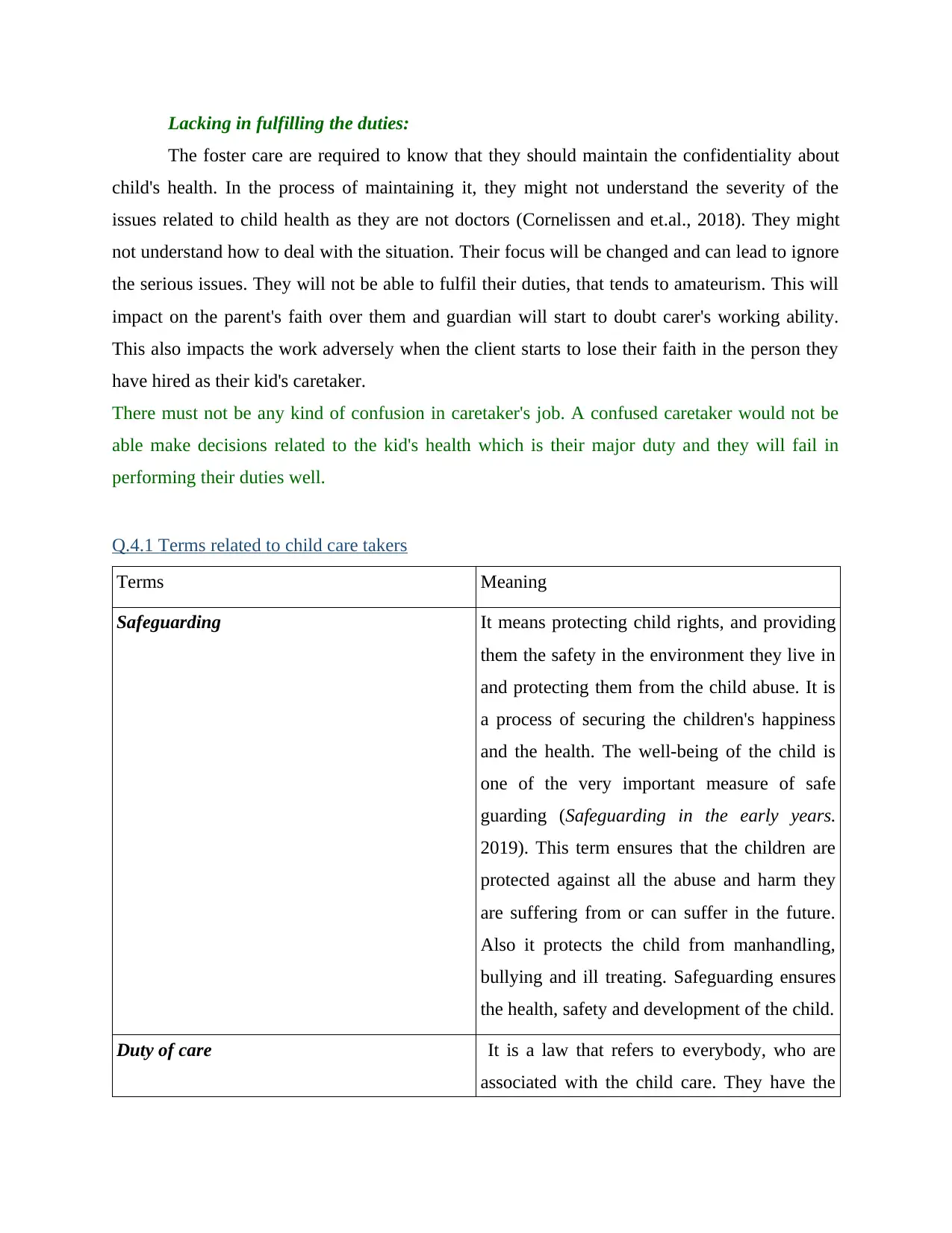
Lacking in fulfilling the duties:
The foster care are required to know that they should maintain the confidentiality about
child's health. In the process of maintaining it, they might not understand the severity of the
issues related to child health as they are not doctors (Cornelissen and et.al., 2018). They might
not understand how to deal with the situation. Their focus will be changed and can lead to ignore
the serious issues. They will not be able to fulfil their duties, that tends to amateurism. This will
impact on the parent's faith over them and guardian will start to doubt carer's working ability.
This also impacts the work adversely when the client starts to lose their faith in the person they
have hired as their kid's caretaker.
There must not be any kind of confusion in caretaker's job. A confused caretaker would not be
able make decisions related to the kid's health which is their major duty and they will fail in
performing their duties well.
Q.4.1 Terms related to child care takers
Terms Meaning
Safeguarding It means protecting child rights, and providing
them the safety in the environment they live in
and protecting them from the child abuse. It is
a process of securing the children's happiness
and the health. The well-being of the child is
one of the very important measure of safe
guarding (Safeguarding in the early years.
2019). This term ensures that the children are
protected against all the abuse and harm they
are suffering from or can suffer in the future.
Also it protects the child from manhandling,
bullying and ill treating. Safeguarding ensures
the health, safety and development of the child.
Duty of care It is a law that refers to everybody, who are
associated with the child care. They have the
The foster care are required to know that they should maintain the confidentiality about
child's health. In the process of maintaining it, they might not understand the severity of the
issues related to child health as they are not doctors (Cornelissen and et.al., 2018). They might
not understand how to deal with the situation. Their focus will be changed and can lead to ignore
the serious issues. They will not be able to fulfil their duties, that tends to amateurism. This will
impact on the parent's faith over them and guardian will start to doubt carer's working ability.
This also impacts the work adversely when the client starts to lose their faith in the person they
have hired as their kid's caretaker.
There must not be any kind of confusion in caretaker's job. A confused caretaker would not be
able make decisions related to the kid's health which is their major duty and they will fail in
performing their duties well.
Q.4.1 Terms related to child care takers
Terms Meaning
Safeguarding It means protecting child rights, and providing
them the safety in the environment they live in
and protecting them from the child abuse. It is
a process of securing the children's happiness
and the health. The well-being of the child is
one of the very important measure of safe
guarding (Safeguarding in the early years.
2019). This term ensures that the children are
protected against all the abuse and harm they
are suffering from or can suffer in the future.
Also it protects the child from manhandling,
bullying and ill treating. Safeguarding ensures
the health, safety and development of the child.
Duty of care It is a law that refers to everybody, who are
associated with the child care. They have the
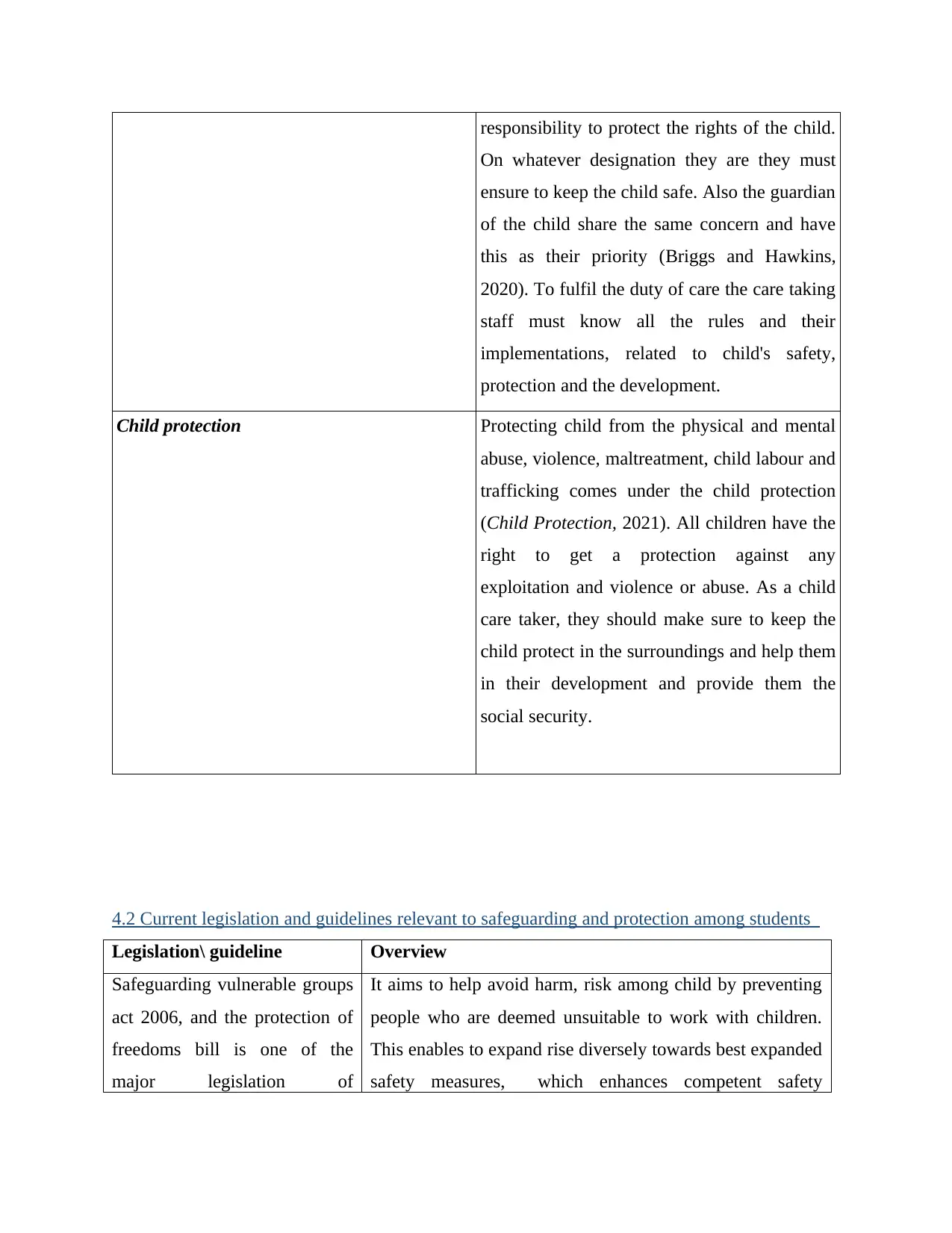
responsibility to protect the rights of the child.
On whatever designation they are they must
ensure to keep the child safe. Also the guardian
of the child share the same concern and have
this as their priority (Briggs and Hawkins,
2020). To fulfil the duty of care the care taking
staff must know all the rules and their
implementations, related to child's safety,
protection and the development.
Child protection Protecting child from the physical and mental
abuse, violence, maltreatment, child labour and
trafficking comes under the child protection
(Child Protection, 2021). All children have the
right to get a protection against any
exploitation and violence or abuse. As a child
care taker, they should make sure to keep the
child protect in the surroundings and help them
in their development and provide them the
social security.
4.2 Current legislation and guidelines relevant to safeguarding and protection among students
Legislation\ guideline Overview
Safeguarding vulnerable groups
act 2006, and the protection of
freedoms bill is one of the
major legislation of
It aims to help avoid harm, risk among child by preventing
people who are deemed unsuitable to work with children.
This enables to expand rise diversely towards best expanded
safety measures, which enhances competent safety
On whatever designation they are they must
ensure to keep the child safe. Also the guardian
of the child share the same concern and have
this as their priority (Briggs and Hawkins,
2020). To fulfil the duty of care the care taking
staff must know all the rules and their
implementations, related to child's safety,
protection and the development.
Child protection Protecting child from the physical and mental
abuse, violence, maltreatment, child labour and
trafficking comes under the child protection
(Child Protection, 2021). All children have the
right to get a protection against any
exploitation and violence or abuse. As a child
care taker, they should make sure to keep the
child protect in the surroundings and help them
in their development and provide them the
social security.
4.2 Current legislation and guidelines relevant to safeguarding and protection among students
Legislation\ guideline Overview
Safeguarding vulnerable groups
act 2006, and the protection of
freedoms bill is one of the
major legislation of
It aims to help avoid harm, risk among child by preventing
people who are deemed unsuitable to work with children.
This enables to expand rise diversely towards best expanded
safety measures, which enhances competent safety
Secure Best Marks with AI Grader
Need help grading? Try our AI Grader for instant feedback on your assignments.

safeguarding and protection
among children.
.
measures and protection goals rapidly.
The children and social work
act 2017-
It aims to provide children best protection and safety
protection aspects among students, for leveraging
significant rise diversely towards optimum scenarios. The
work care facilitates supervision rise actively, to attain new
functional growth goals diversely.
Keeping children safe in
education, 2019 enables
significant rise on education
and learning procedures in
functional growth scenarios.
It aims to further enhances education learning to be
delivered among students, where care giver needs to
functionally be dynamic in effective safety standards and
protection aspects.
Working together to safeguard
children, 2018
This legislation also holds high significance, for working
together with safeguarding children with better high scale
functional advancement and higher significant rise towards
protection competently.
Guidelines related to
safeguarding and protection
among students
Protecting children from maltreatment and preventing
impairment to health and development aspects, also further
ensuring provision of safety care (Drange and Telle, 2020).
Care givers should also further enable children to have best
chances diversely, synchronizing new specific rapid
engagement rapidly on wider best safety and protection
scenarios.
4.3, 4.4 & 4.5
4.3 Legal responsibilities for protecting children
among children.
.
measures and protection goals rapidly.
The children and social work
act 2017-
It aims to provide children best protection and safety
protection aspects among students, for leveraging
significant rise diversely towards optimum scenarios. The
work care facilitates supervision rise actively, to attain new
functional growth goals diversely.
Keeping children safe in
education, 2019 enables
significant rise on education
and learning procedures in
functional growth scenarios.
It aims to further enhances education learning to be
delivered among students, where care giver needs to
functionally be dynamic in effective safety standards and
protection aspects.
Working together to safeguard
children, 2018
This legislation also holds high significance, for working
together with safeguarding children with better high scale
functional advancement and higher significant rise towards
protection competently.
Guidelines related to
safeguarding and protection
among students
Protecting children from maltreatment and preventing
impairment to health and development aspects, also further
ensuring provision of safety care (Drange and Telle, 2020).
Care givers should also further enable children to have best
chances diversely, synchronizing new specific rapid
engagement rapidly on wider best safety and protection
scenarios.
4.3, 4.4 & 4.5
4.3 Legal responsibilities for protecting children
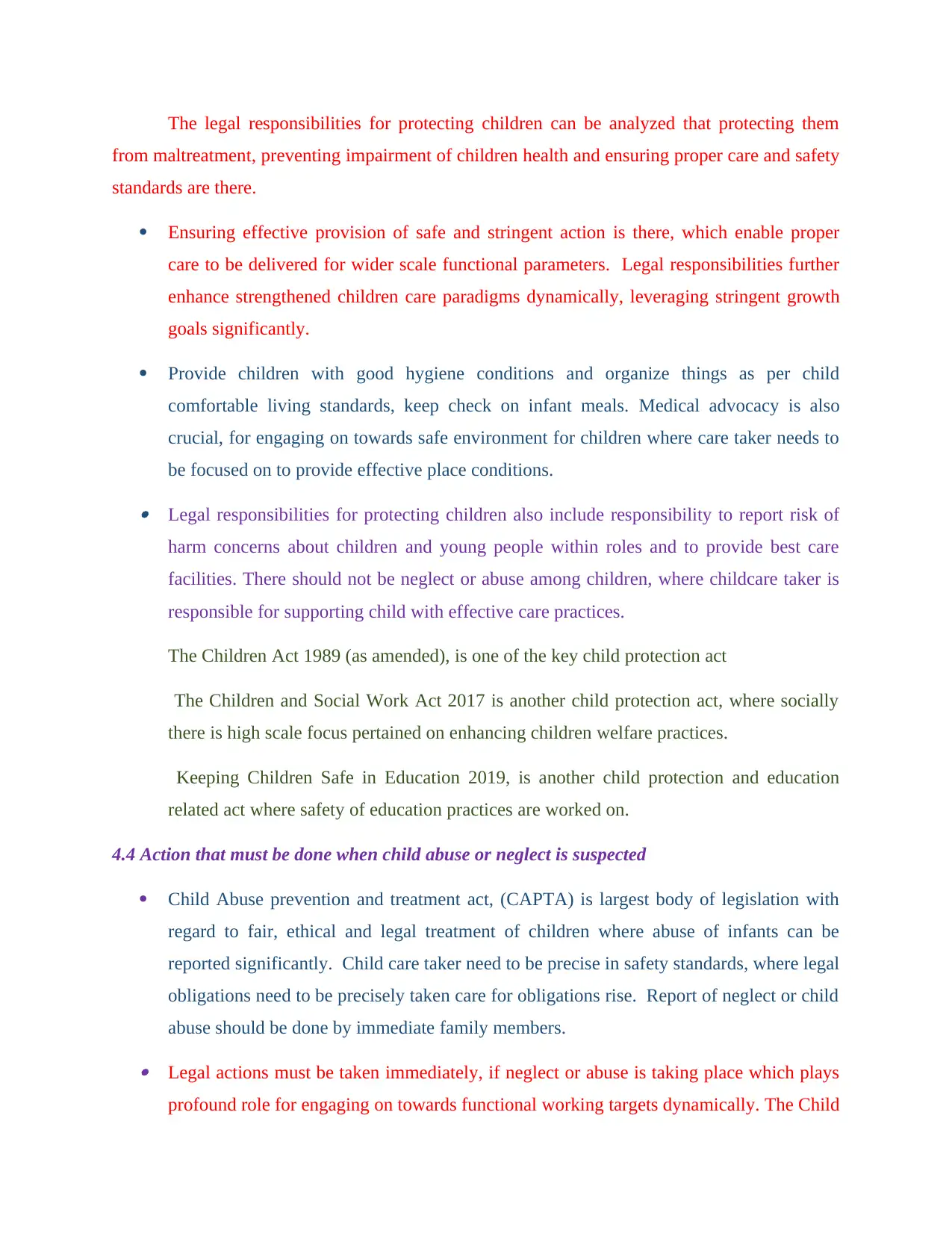
The legal responsibilities for protecting children can be analyzed that protecting them
from maltreatment, preventing impairment of children health and ensuring proper care and safety
standards are there.
Ensuring effective provision of safe and stringent action is there, which enable proper
care to be delivered for wider scale functional parameters. Legal responsibilities further
enhance strengthened children care paradigms dynamically, leveraging stringent growth
goals significantly.
Provide children with good hygiene conditions and organize things as per child
comfortable living standards, keep check on infant meals. Medical advocacy is also
crucial, for engaging on towards safe environment for children where care taker needs to
be focused on to provide effective place conditions. Legal responsibilities for protecting children also include responsibility to report risk of
harm concerns about children and young people within roles and to provide best care
facilities. There should not be neglect or abuse among children, where childcare taker is
responsible for supporting child with effective care practices.
The Children Act 1989 (as amended), is one of the key child protection act
The Children and Social Work Act 2017 is another child protection act, where socially
there is high scale focus pertained on enhancing children welfare practices.
Keeping Children Safe in Education 2019, is another child protection and education
related act where safety of education practices are worked on.
4.4 Action that must be done when child abuse or neglect is suspected
Child Abuse prevention and treatment act, (CAPTA) is largest body of legislation with
regard to fair, ethical and legal treatment of children where abuse of infants can be
reported significantly. Child care taker need to be precise in safety standards, where legal
obligations need to be precisely taken care for obligations rise. Report of neglect or child
abuse should be done by immediate family members. Legal actions must be taken immediately, if neglect or abuse is taking place which plays
profound role for engaging on towards functional working targets dynamically. The Child
from maltreatment, preventing impairment of children health and ensuring proper care and safety
standards are there.
Ensuring effective provision of safe and stringent action is there, which enable proper
care to be delivered for wider scale functional parameters. Legal responsibilities further
enhance strengthened children care paradigms dynamically, leveraging stringent growth
goals significantly.
Provide children with good hygiene conditions and organize things as per child
comfortable living standards, keep check on infant meals. Medical advocacy is also
crucial, for engaging on towards safe environment for children where care taker needs to
be focused on to provide effective place conditions. Legal responsibilities for protecting children also include responsibility to report risk of
harm concerns about children and young people within roles and to provide best care
facilities. There should not be neglect or abuse among children, where childcare taker is
responsible for supporting child with effective care practices.
The Children Act 1989 (as amended), is one of the key child protection act
The Children and Social Work Act 2017 is another child protection act, where socially
there is high scale focus pertained on enhancing children welfare practices.
Keeping Children Safe in Education 2019, is another child protection and education
related act where safety of education practices are worked on.
4.4 Action that must be done when child abuse or neglect is suspected
Child Abuse prevention and treatment act, (CAPTA) is largest body of legislation with
regard to fair, ethical and legal treatment of children where abuse of infants can be
reported significantly. Child care taker need to be precise in safety standards, where legal
obligations need to be precisely taken care for obligations rise. Report of neglect or child
abuse should be done by immediate family members. Legal actions must be taken immediately, if neglect or abuse is taking place which plays
profound role for engaging on towards functional working targets dynamically. The Child
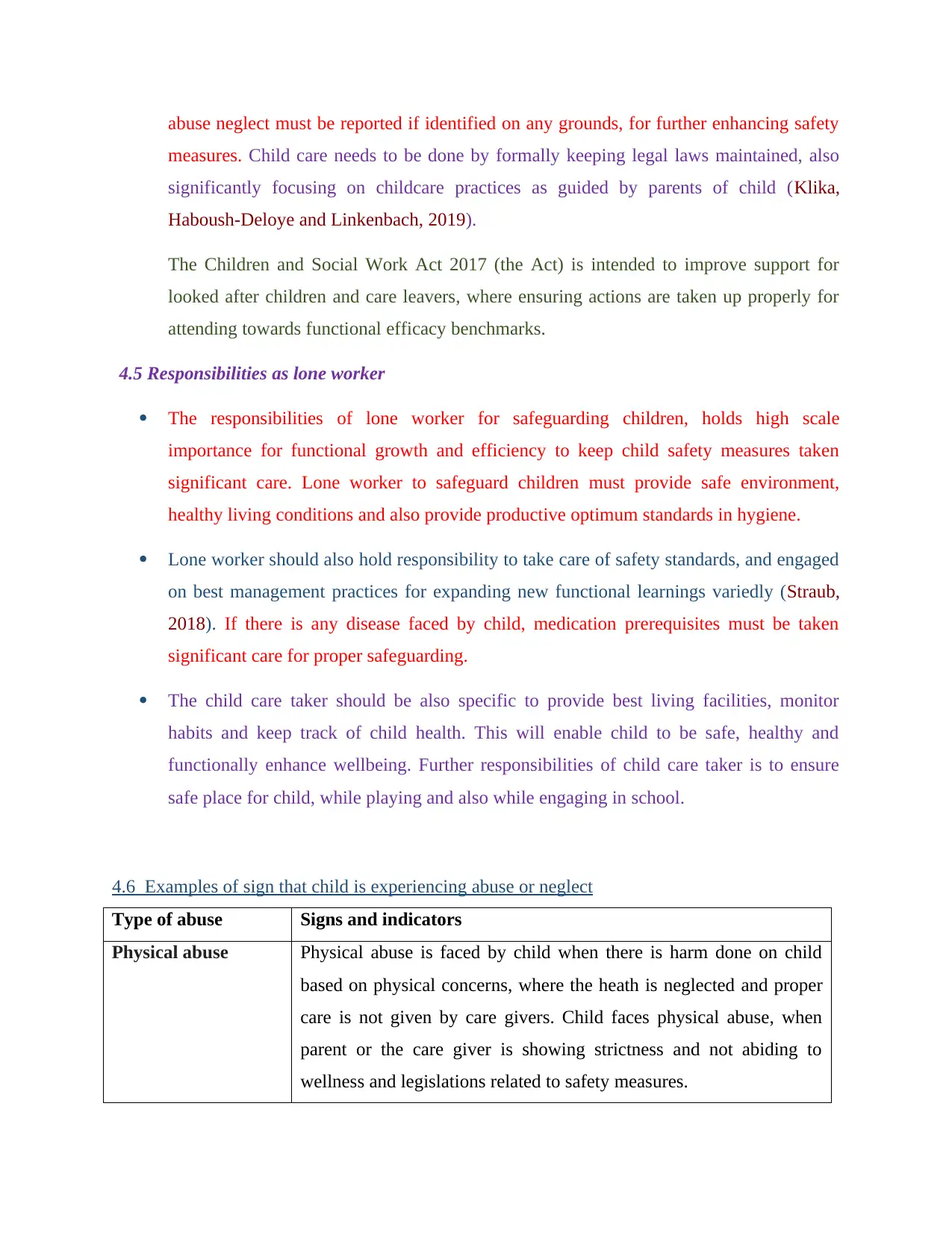
abuse neglect must be reported if identified on any grounds, for further enhancing safety
measures. Child care needs to be done by formally keeping legal laws maintained, also
significantly focusing on childcare practices as guided by parents of child (Klika,
Haboush-Deloye and Linkenbach, 2019).
The Children and Social Work Act 2017 (the Act) is intended to improve support for
looked after children and care leavers, where ensuring actions are taken up properly for
attending towards functional efficacy benchmarks.
4.5 Responsibilities as lone worker
The responsibilities of lone worker for safeguarding children, holds high scale
importance for functional growth and efficiency to keep child safety measures taken
significant care. Lone worker to safeguard children must provide safe environment,
healthy living conditions and also provide productive optimum standards in hygiene.
Lone worker should also hold responsibility to take care of safety standards, and engaged
on best management practices for expanding new functional learnings variedly (Straub,
2018). If there is any disease faced by child, medication prerequisites must be taken
significant care for proper safeguarding.
The child care taker should be also specific to provide best living facilities, monitor
habits and keep track of child health. This will enable child to be safe, healthy and
functionally enhance wellbeing. Further responsibilities of child care taker is to ensure
safe place for child, while playing and also while engaging in school.
4.6 Examples of sign that child is experiencing abuse or neglect
Type of abuse Signs and indicators
Physical abuse Physical abuse is faced by child when there is harm done on child
based on physical concerns, where the heath is neglected and proper
care is not given by care givers. Child faces physical abuse, when
parent or the care giver is showing strictness and not abiding to
wellness and legislations related to safety measures.
measures. Child care needs to be done by formally keeping legal laws maintained, also
significantly focusing on childcare practices as guided by parents of child (Klika,
Haboush-Deloye and Linkenbach, 2019).
The Children and Social Work Act 2017 (the Act) is intended to improve support for
looked after children and care leavers, where ensuring actions are taken up properly for
attending towards functional efficacy benchmarks.
4.5 Responsibilities as lone worker
The responsibilities of lone worker for safeguarding children, holds high scale
importance for functional growth and efficiency to keep child safety measures taken
significant care. Lone worker to safeguard children must provide safe environment,
healthy living conditions and also provide productive optimum standards in hygiene.
Lone worker should also hold responsibility to take care of safety standards, and engaged
on best management practices for expanding new functional learnings variedly (Straub,
2018). If there is any disease faced by child, medication prerequisites must be taken
significant care for proper safeguarding.
The child care taker should be also specific to provide best living facilities, monitor
habits and keep track of child health. This will enable child to be safe, healthy and
functionally enhance wellbeing. Further responsibilities of child care taker is to ensure
safe place for child, while playing and also while engaging in school.
4.6 Examples of sign that child is experiencing abuse or neglect
Type of abuse Signs and indicators
Physical abuse Physical abuse is faced by child when there is harm done on child
based on physical concerns, where the heath is neglected and proper
care is not given by care givers. Child faces physical abuse, when
parent or the care giver is showing strictness and not abiding to
wellness and legislations related to safety measures.
Paraphrase This Document
Need a fresh take? Get an instant paraphrase of this document with our AI Paraphraser
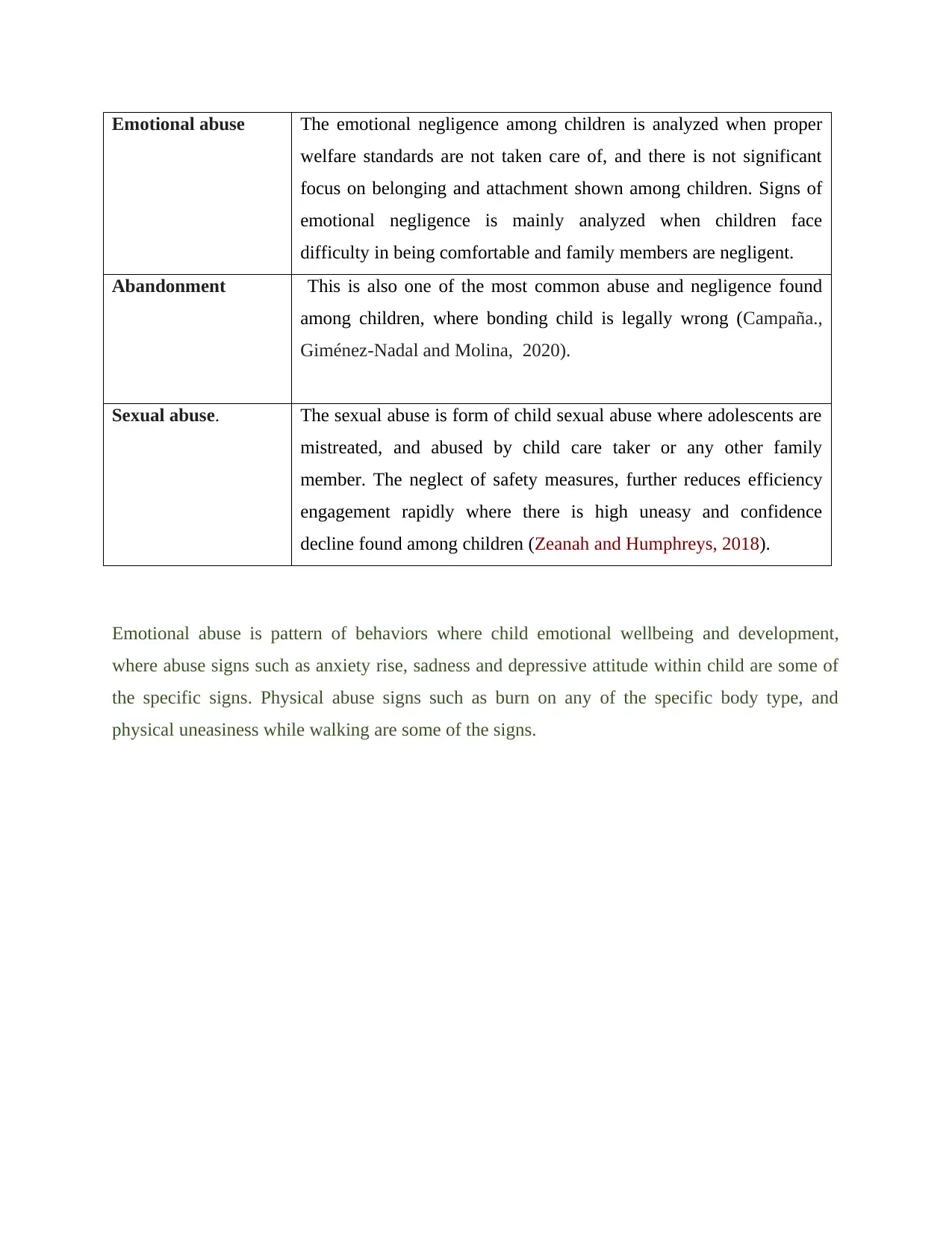
Emotional abuse The emotional negligence among children is analyzed when proper
welfare standards are not taken care of, and there is not significant
focus on belonging and attachment shown among children. Signs of
emotional negligence is mainly analyzed when children face
difficulty in being comfortable and family members are negligent.
Abandonment This is also one of the most common abuse and negligence found
among children, where bonding child is legally wrong (Campaña.,
Giménez-Nadal and Molina, 2020).
Sexual abuse. The sexual abuse is form of child sexual abuse where adolescents are
mistreated, and abused by child care taker or any other family
member. The neglect of safety measures, further reduces efficiency
engagement rapidly where there is high uneasy and confidence
decline found among children (Zeanah and Humphreys, 2018).
Emotional abuse is pattern of behaviors where child emotional wellbeing and development,
where abuse signs such as anxiety rise, sadness and depressive attitude within child are some of
the specific signs. Physical abuse signs such as burn on any of the specific body type, and
physical uneasiness while walking are some of the signs.
welfare standards are not taken care of, and there is not significant
focus on belonging and attachment shown among children. Signs of
emotional negligence is mainly analyzed when children face
difficulty in being comfortable and family members are negligent.
Abandonment This is also one of the most common abuse and negligence found
among children, where bonding child is legally wrong (Campaña.,
Giménez-Nadal and Molina, 2020).
Sexual abuse. The sexual abuse is form of child sexual abuse where adolescents are
mistreated, and abused by child care taker or any other family
member. The neglect of safety measures, further reduces efficiency
engagement rapidly where there is high uneasy and confidence
decline found among children (Zeanah and Humphreys, 2018).
Emotional abuse is pattern of behaviors where child emotional wellbeing and development,
where abuse signs such as anxiety rise, sadness and depressive attitude within child are some of
the specific signs. Physical abuse signs such as burn on any of the specific body type, and
physical uneasiness while walking are some of the signs.

REFRENCES
Books and Journals
Beelmann, A. and Lösel, F., 2021. A comprehensive meta-analysis of randomized evaluations of
the effect of child social skills training on antisocial development. Journal of
Developmental and Life-Course Criminology, 7(1), pp.41-65.
Briggs, F. and Hawkins, R., 2020. Child protection: A guide for teachers and child care
professionals. Routledge.
Briggs, F. and Hawkins, R., 2020. Child protection: A guide for teachers and child care
professionals. Routledge.
Briggs, F. and Hawkins, R., 2020. Child protection: A guide for teachers and child care
professionals. Routledge.
Cabrera, N. J., and et.al, 2020. Cognitive Stimulation at Home and in Child Care and Children’s
Preacademic Skills in Two‐Parent Families. Child development, 91(5), pp.1709-
1717.
Campaña, J.C., Giménez-Nadal, J.I. and Molina, J.A., 2020. Self-employed and employed
mothers in Latin American families: Are there differences in paid work, unpaid
work, and child care?. Journal of Family and Economic Issues, 41(1), pp.52-69.
Collings, S. and Wright, A.C., 2019. Permanency with lifelong connections: Casework practices
to support positive relationships between carer and birth families.
Cornelissen, T. and et.al., 2018. Who benefits from universal child care? Estimating marginal
returns to early child care attendance. Journal of Political Economy. 126(6)
pp.2356-2409.
Drange, N. and Telle, K., 2020. Segregation in a universal child care system: Descriptive
findings from Norway. European Sociological Review, 36(6), pp.886-901.
Ferreira, A.I., Quintão, C. and Quaresma, C., 2021, July. Assessment of Visuomotor and Visual
Perception Skills in Children: A New Proposal Based on a Systematic Review.
In Doctoral Conference on Computing, Electrical and Industrial Systems (pp.
273-284). Springer, Cham.
Harding, L. and et.al., 2018. High stress experienced in the foster and kin carer role:
Understanding the complexities of the carer and child in context. Children and
Youth Services Review. 95. pp.316-326.
Joseph, S. and et.al., 2020. Young carers research, practice and policy: an overview and critical
perspective on possible future directions. Adolescent Research Review. 5(1).
pp.77-89.
Klika, J.B., Haboush-Deloye, A. and Linkenbach, J., 2019. Hidden protections: Identifying
social norms associated with child abuse, sexual abuse, and neglect. Child and
adolescent social work journal. 36(1). pp.5-14.
Books and Journals
Beelmann, A. and Lösel, F., 2021. A comprehensive meta-analysis of randomized evaluations of
the effect of child social skills training on antisocial development. Journal of
Developmental and Life-Course Criminology, 7(1), pp.41-65.
Briggs, F. and Hawkins, R., 2020. Child protection: A guide for teachers and child care
professionals. Routledge.
Briggs, F. and Hawkins, R., 2020. Child protection: A guide for teachers and child care
professionals. Routledge.
Briggs, F. and Hawkins, R., 2020. Child protection: A guide for teachers and child care
professionals. Routledge.
Cabrera, N. J., and et.al, 2020. Cognitive Stimulation at Home and in Child Care and Children’s
Preacademic Skills in Two‐Parent Families. Child development, 91(5), pp.1709-
1717.
Campaña, J.C., Giménez-Nadal, J.I. and Molina, J.A., 2020. Self-employed and employed
mothers in Latin American families: Are there differences in paid work, unpaid
work, and child care?. Journal of Family and Economic Issues, 41(1), pp.52-69.
Collings, S. and Wright, A.C., 2019. Permanency with lifelong connections: Casework practices
to support positive relationships between carer and birth families.
Cornelissen, T. and et.al., 2018. Who benefits from universal child care? Estimating marginal
returns to early child care attendance. Journal of Political Economy. 126(6)
pp.2356-2409.
Drange, N. and Telle, K., 2020. Segregation in a universal child care system: Descriptive
findings from Norway. European Sociological Review, 36(6), pp.886-901.
Ferreira, A.I., Quintão, C. and Quaresma, C., 2021, July. Assessment of Visuomotor and Visual
Perception Skills in Children: A New Proposal Based on a Systematic Review.
In Doctoral Conference on Computing, Electrical and Industrial Systems (pp.
273-284). Springer, Cham.
Harding, L. and et.al., 2018. High stress experienced in the foster and kin carer role:
Understanding the complexities of the carer and child in context. Children and
Youth Services Review. 95. pp.316-326.
Joseph, S. and et.al., 2020. Young carers research, practice and policy: an overview and critical
perspective on possible future directions. Adolescent Research Review. 5(1).
pp.77-89.
Klika, J.B., Haboush-Deloye, A. and Linkenbach, J., 2019. Hidden protections: Identifying
social norms associated with child abuse, sexual abuse, and neglect. Child and
adolescent social work journal. 36(1). pp.5-14.

Li, and et.al., 2020. Microplastic release from the degradation of polypropylene feeding bottles
during infant formula preparation. Nature Food. 1(11). pp.746-754.
Madigan, S., and et.al, 2020. Associations between screen use and child language skills: a
systematic review and meta-analysis. JAMA pediatrics, 174(7), pp.665-675.
MAHSAN, I., MOUSTAFA, E.S., ABED, A. and DN, S., 2020. The Relationship between
Nursing Staff Communication Skills and Quality of Nursing Care in A Pediatric
University Specialized Hospital. The Medical Journal of Cairo
University, 88(March), pp.305-310.
Marusinec, R. and et.al., 2021. Caretaker knowledge, attitudes, and practices (KAP) and carriage
of extended-spectrum beta-lactamase-producing E. coli (ESBL-EC) in children
in Quito, Ecuador.Antimicrobial Resistance & Infection Control. 10(1). pp.1-12.
Strasser, K., Barra, G. and Mendive, S., 2021. The role of video analysis and deliberate rehearsal
in the development of language stimulation skills in pre-service preschool
teacher preparation: An experimental study. Teaching and Teacher
Education, 106, p.103459.
Straub, F., 2018. High Risk, Lone Worker: The Unacceptable Risk. Professional Safety. 63(07).
pp.30-35.
Sweeney, M., 2021. Innovations in Practice Learning, Edited by Dr Sue Taplin: Critical Skills
for Social Work. The Journal of Practice Teaching and Learning.
World Health Organization, 2017. Safe management of wastes from health-care activities: a
summary (No. WHO/FWC/WSH/17.05). World Health Organization.
Wu, and et.al., 2017. Point-of-care detection devices for food safety monitoring: proactive
disease prevention. Trends in biotechnology. 35(4). pp.288-300.
Zeanah, C.H. and Humphreys, K.L., 2018. Child abuse and neglect. Journal of the American
Academy of Child & Adolescent Psychiatry. 57(9). pp.637-644.
Online references
Child Protection. 2021. [Online]. Available through <https://www.unicef.org/protection>.
[Accessed on 10th August 2021].
In-Home Caregiver Tips for a Successful First Day on the Job. 2021. [Online]. Available
through <https://homecareassist.com/2018/08/08/in-home-caregiver-tips-for-a-
successful-first-day-on-the-job/#:~:text=Make%20a%20positive%20first
%20impression,can%20be%20a%20wonderful%20icebreaker.>. [Accessed on 9th
August 2021].
Safeguarding in the early years. 2019. [Online]. Available through
<https://www.eyalliance.org.uk/safeguarding-early-years#:~:text=The%20term
%20safeguarding%20is%20used,of%20children's%20health%20or
%20development&text=Taking%20action%20to%20enable%20all%20children
%20to%20have%20the%20best%20outcomes.>. [Accessed on 10th August 2021].
during infant formula preparation. Nature Food. 1(11). pp.746-754.
Madigan, S., and et.al, 2020. Associations between screen use and child language skills: a
systematic review and meta-analysis. JAMA pediatrics, 174(7), pp.665-675.
MAHSAN, I., MOUSTAFA, E.S., ABED, A. and DN, S., 2020. The Relationship between
Nursing Staff Communication Skills and Quality of Nursing Care in A Pediatric
University Specialized Hospital. The Medical Journal of Cairo
University, 88(March), pp.305-310.
Marusinec, R. and et.al., 2021. Caretaker knowledge, attitudes, and practices (KAP) and carriage
of extended-spectrum beta-lactamase-producing E. coli (ESBL-EC) in children
in Quito, Ecuador.Antimicrobial Resistance & Infection Control. 10(1). pp.1-12.
Strasser, K., Barra, G. and Mendive, S., 2021. The role of video analysis and deliberate rehearsal
in the development of language stimulation skills in pre-service preschool
teacher preparation: An experimental study. Teaching and Teacher
Education, 106, p.103459.
Straub, F., 2018. High Risk, Lone Worker: The Unacceptable Risk. Professional Safety. 63(07).
pp.30-35.
Sweeney, M., 2021. Innovations in Practice Learning, Edited by Dr Sue Taplin: Critical Skills
for Social Work. The Journal of Practice Teaching and Learning.
World Health Organization, 2017. Safe management of wastes from health-care activities: a
summary (No. WHO/FWC/WSH/17.05). World Health Organization.
Wu, and et.al., 2017. Point-of-care detection devices for food safety monitoring: proactive
disease prevention. Trends in biotechnology. 35(4). pp.288-300.
Zeanah, C.H. and Humphreys, K.L., 2018. Child abuse and neglect. Journal of the American
Academy of Child & Adolescent Psychiatry. 57(9). pp.637-644.
Online references
Child Protection. 2021. [Online]. Available through <https://www.unicef.org/protection>.
[Accessed on 10th August 2021].
In-Home Caregiver Tips for a Successful First Day on the Job. 2021. [Online]. Available
through <https://homecareassist.com/2018/08/08/in-home-caregiver-tips-for-a-
successful-first-day-on-the-job/#:~:text=Make%20a%20positive%20first
%20impression,can%20be%20a%20wonderful%20icebreaker.>. [Accessed on 9th
August 2021].
Safeguarding in the early years. 2019. [Online]. Available through
<https://www.eyalliance.org.uk/safeguarding-early-years#:~:text=The%20term
%20safeguarding%20is%20used,of%20children's%20health%20or
%20development&text=Taking%20action%20to%20enable%20all%20children
%20to%20have%20the%20best%20outcomes.>. [Accessed on 10th August 2021].
Secure Best Marks with AI Grader
Need help grading? Try our AI Grader for instant feedback on your assignments.

.
1 out of 23
Related Documents
Your All-in-One AI-Powered Toolkit for Academic Success.
+13062052269
info@desklib.com
Available 24*7 on WhatsApp / Email
![[object Object]](/_next/static/media/star-bottom.7253800d.svg)
Unlock your academic potential
© 2024 | Zucol Services PVT LTD | All rights reserved.




